Turquoise Energy News/Report #169
covering June
2022 (Posted July 9th 2022)
Lawnhill BC Canada - by Craig Carmichael
www.TurquoiseEnergy.com
= www.ElectricCaik.com
= www.ElectricHubcap.com
Month
In
"Brief"
(Project Summaries etc.)
- Misc - New Chemie Battery - DIY EV Stuff - Sea Glider
Electric Ground Effect Ferry: a Critique -
Water as energy storage? - Solar Deep Well Pump - New 302AH LiPo Cells
In
Passing
(Miscellaneous topics, editorial comments & opinionated rants)
- Everybody's Garbage Problem - USA: "Civil Service" Run Amok -
Russia & Ukraine Again (Oh no, not again!) - Smol
Thots - ESD
- Detailed
Project Reports
-
Electric
Transport - Electric Hubcap Motor Systems [no reports]
Other "Green"
& Electric Equipment Projects
* Gardening
* Plastic Recycling 2.0
* Lawn Grass Building Wall Insulation
Electricity Storage:
Batteries
* Gelled Nickel Zinc
Flat cell with external face clamps
Electricity Generation
* My Solar Power System:
- Latest Daily/Monthly
Solar Production log et cetera - Monthly/Annual Summaries,
Estimates, Notes
 I spent a lot
of time on gardening again. Nevertheless the
weeds grow fast and a lot of it looks more like weed patch than garden.
But along with all I'm going to have a lot of potatoes for
calories if the food shortage does go global this coming winter - or
for a few years afterward, since they reseed themselves even if you
think you harvested them all. They've become weeds almost throughout
the garden.
I spent a lot
of time on gardening again. Nevertheless the
weeds grow fast and a lot of it looks more like weed patch than garden.
But along with all I'm going to have a lot of potatoes for
calories if the food shortage does go global this coming winter - or
for a few years afterward, since they reseed themselves even if you
think you harvested them all. They've become weeds almost throughout
the garden.
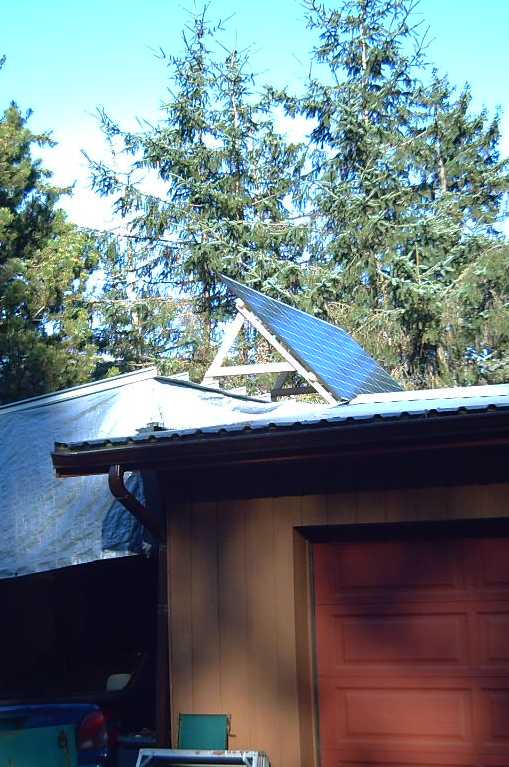 The solar panels again did much better with the
two panels on the pole and more especially with the three new
panels on the carport roof (sunniest place), yielding 536 KWH for the
month from the 18
panels. Until this year, 330 KWH was about the summer maximum
production from 12 or 13 panels. When I can find the time, I'll move
the three panels on the lawn also
onto the carport roof beside the first three.
The solar panels again did much better with the
two panels on the pole and more especially with the three new
panels on the carport roof (sunniest place), yielding 536 KWH for the
month from the 18
panels. Until this year, 330 KWH was about the summer maximum
production from 12 or 13 panels. When I can find the time, I'll move
the three panels on the lawn also
onto the carport roof beside the first three.
Plastic Recycling 2.0
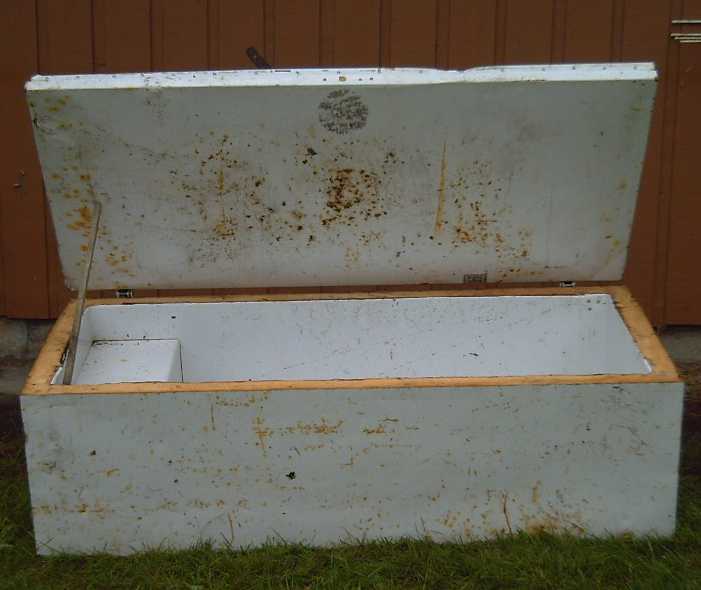 I did
patheticly little work on the
"freezer-as-plastic-melting-oven", making the two-piece lid from two
freezer lids, with fiberglass insulation lower and sprayed foam molded
on the upper. In doing this I had to put the smaller one on top, so if
I leave it in the rain it will run inside the lid around the edges. I
suppose I should put rock wool or something around the rim since it's
no seal.
I did
patheticly little work on the
"freezer-as-plastic-melting-oven", making the two-piece lid from two
freezer lids, with fiberglass insulation lower and sprayed foam molded
on the upper. In doing this I had to put the smaller one on top, so if
I leave it in the rain it will run inside the lid around the edges. I
suppose I should put rock wool or something around the rim since it's
no seal.
Finally I started on the heating controls and element but
I misplaced a part and had to stop. I found it days later (July 4th) in
my clutter.
New Chemie Battery
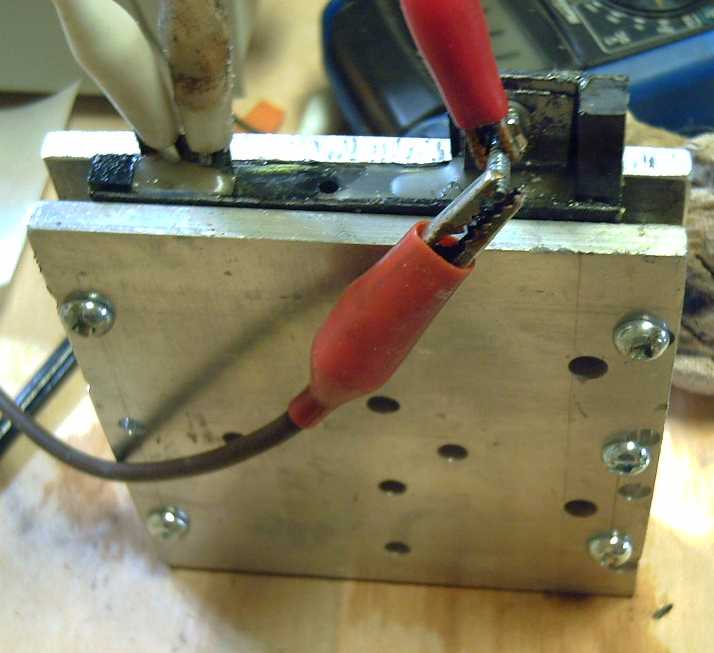 I tried making
a new Ni-Zn gelled battery cell. It didn't work well but I made a
little progress in improving the construction and I have a couple of
ideas to fix problems for next try(s). The agar gel seems again to
block current flow. (I thought I had it working well about 3 years ago!)
I tried making
a new Ni-Zn gelled battery cell. It didn't work well but I made a
little progress in improving the construction and I have a couple of
ideas to fix problems for next try(s). The agar gel seems again to
block current flow. (I thought I had it working well about 3 years ago!)
The main new idea in deciding to make it was to use an
external clamp
set for flat faced cells to prevent them from bulging. (Normally one
clamp set would be used with multiple cells stacked in a row.) This
should
prevent the positive powder/paste electrodes from swelling by bulging
out the flat faces, and losing their electrical conductivity in the
process. A successful flat plate cell will eliminate my desire to make
copper bodied cylindrical cells, which seems to be beyond my level of
metal working techniques.
Some features of the 'failed' cell
seemed to be progress:
1. The external clamps idea. Of course, multiple cells for a higher
working
voltage (12V, 36V...) would be sandwiched in one clamp set.
2. Using plumber's ABS cement instead of methylene chloride to 'glue'
the case pieces together. Although the cell leaked at first, smearing
some more ABS cement on the joins fixed it, where it rarely did with
methylene chloride. (If
only I could make them not leak in the first place... but there's
almost no way to test them until the cell is filled.)
3. Melted beeswax seemed to seal the electrode terminals well. But it
wasn't a complete test because of the initial leak.
4. I got two ideas about the gelling to prevent zincate ion migration:
(a) to incorporate potassium chloride into the gel when making it might
give it the good current flow capacity that is now lacking; and (b) to
try PVA (poly vinyl alcohol) as a gel instead of agar. I've ordered
some.
I think I may have already tried incorporating potassium
chloride into an agar gel. Maybe that was one that worked well? If so I
missed that that had been a factor in the success at the time. (I
should read over some of my
earlier TE News battery work! 2019?)
I also did a bit of reading on PVA. Evidently it gels if
frozen to -20°c overnight or for 24 hours and then thawed again,
about 4 times. That would allow making the cell and adding chloride
salt
electrolyte [with ?10% PVA] as a liquid solution, then turning it into
a "battery lasts forever"
gel after construction.
[July 7th] Late note: I pried the top face off the cell. To my surprise
I did it without destroying it. The ABS cement seems to make a much
weaker bond than methylene chloride. I found the beeswax had flowed
deep into the cell and had blocked my attempted refillings of the
leaked electrolyte. It looked very dry inside. I added KCl electrolyte
and put it on charge and soon it was performing properly again, with a
momentary short circuit current of over 1.5 amps.
DIY EV Stuff
I thought I would try a 6 to 1 planetary reduction in the
Chevy Sprint and see how much more 'pep' and hill climbing ability it
would have than with the 5 to 1, without reducing the already low top
speed too much. In a table were listed 2 to 1 up to 10
to 1, and I ordered 6. It turns out that 6 to 1 isn't actually
available. It
was 7 to 1 or forget it, and I decided on the latter. I may not have
got to it this year or next anyway. Better to get the EV truck on the
road again.
I had put the planetary gear and connecting shaft on the
Miles EV truck to replace the crappy transmission, but it started to
dawn on me that with them not being
firmly affixed to each other, the spline on the shaft would likely
twist and move around a bit, and probably wear out pretty fast. (And I
had pretty poor results trying to connect anything but the original
splined shaft to the motor.) I got a 3 inch
alume pipe, intending to make plates for the ends to bolt to the motor
at the front and the planetary at the back. Then they would be solidly
attached together in a very basic "transmission housing".
So now I'm going to see if my MIG welder with flux core
alume alloy wire will do some
basic alume welding without an inert gas tank connected. If it works
and does the basics for
simple jobs I'll be content.
Sea Glider Electric Ground Effect Craft (by Regent,
Boston USA): a Critique
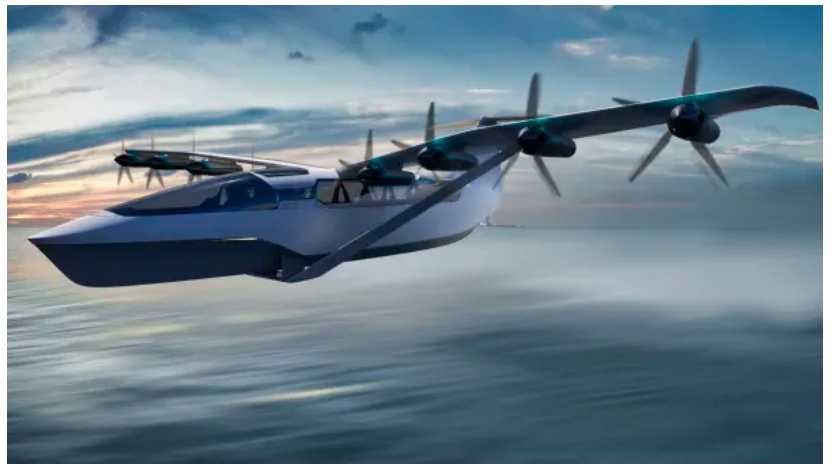 The "Sea Glider" concept as a computer image.
The "Sea Glider" concept as a computer image.
The hydrofoil as shown could be a great wing structural reinforcement,
but it
would make docking more difficult.
New ideas for an "electric ground effect ferry" are being
promoted by two MIT engineers who seem to have lots of financial
backing. Mostly, the layout looks
like all those familiar "hard to fly", "tried and abandoned" ground
effect
craft designs. The wing is long and narrow, which produces the least
ground effect lift -- that is, similar ground effect is to be had
higher up with a wider, shorter wing. But the wing can't be
lowered owing to the open propellers on motors underneath it. And it
has the
typical high-up rear elevator suitable for high altitude aircraft
instead of
an "instant pitch & elevation control" front canard, which should
provide much superior longitudinal control and stability
for a ground effect craft, but which is outside the range of thinking
of most
aeronautical engineers. (To be fair it was outside my range of thinking
for 2 or 3 years into my own project, too.) And it appears to be only
computer images to show the concept so far, not an actual working
craft. I
expect that once built it will have the same problems, especially in
rough seas, that previous ground effect craft seem to have had. And to
avoid wasting resources it should be built first as a radio controlled
model. That might safely and economicly show up any number of
shortcomings, but I
didn't see it proposed.
But there are two design innovations. First it's electric
with
eight open propellers instead of fossil fuel driven. It would take
advantage of the lower energy usage of a ground effect craft compared
to
a high-flying aircraft to have double the range with the same "X"
battery capacity. (With my design I hope
for at least 3 times the range.) Then, by having so many props, they
can be smaller and so
made to clear the waves with a lower wing. Still it's less effective
(IMHO) than still smaller diameter ducted fan propellers on a
canard would be (which leaves the propellerless main wing to be almost
down at the water line near the bottom of the craft for considerably
more ground effect). I don't have
calculations and figures for this, but it
seems obvious that more propeller clearance with a lower wing is going
to allow more ground effect lift, and mounted on a canard the craft
will
be more responsive and seaworthy at the lowest altitudes. The extra
static thrust from ducted fans will obviously improve takeoffs, and of
course it
is further improved by being able to aim the canard up a little, so the
fans
blow the air under the wing(s) with a hovercraft-like additional lift
before flying speed is attained.
Second it has what appears to be a
hydrofoil component.
I imagine that this should reduce the power needed for water
takeoffs. Instead of getting up "on the step", it gets up onto the
hydrofoil which has upper and lower surface lift, surely allowing for
acceleration to flight speed with less power.
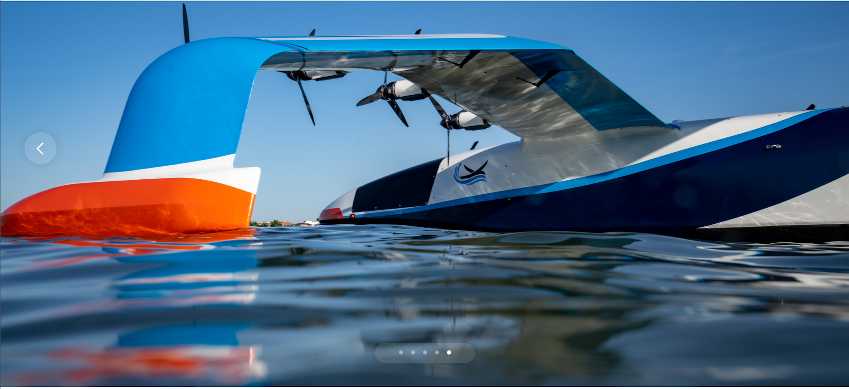 Altered "Sea Glider" concept with wingtip
flotation, also providing wingtip vortex reduction.
Altered "Sea Glider" concept with wingtip
flotation, also providing wingtip vortex reduction.
As shown, this would make it almost problematic to dock at any typical
wharf or float.
(A 'catamaran' design allows one float to pull right up next to a wharf
- and it
assumes any passengers on the far side can walk across the wide wing.)
Also noted: here the under wing motors seem to have become over the
wing, but still the wing
seems so high up as to be getting out of best ground effect range even
while sitting on the water.
One image differs from the rest, showing a float on the
end of a wing, and the wingtip bends down to meet it on the water. This
would reduce end turbulence losses, similar to a catamaran layout or
to the very large radio controlled "Wises" model with a canard that
seemed so
responsive on youtube. (I think I linked to that video in some TE News
issue some years back.) So it looks like the design isn't entirely set
in stone
yet.
But I suppose my sorts of designs would be so different to
their
visualizations and plans that they would reject them out of hand.
Explaining any major change(s) of form to their
"great design" as "pitched" to multiple investors could easily be a
problem. The investors might see it as some
admission that the team has found that their "fabulous" design was
flawed and that they are unclear about what they are doing, rather than
accepting it as a new concept that, while substantially altering the
layout, should improve the potential viability and
practicality of the whole project. The visual is the easily grasped and
the investors probably largely
"bought into" the idea more on the imagery presented and the
engineering credentials of the proponents than what might unfold under
actual development if it no longer matches the images. (I think that's
a reason it's so hard to find funding for experimental development.
Investors want the earlier experimental phases to (somehow, without
funding) be complete and the design solidified before funding
something.)
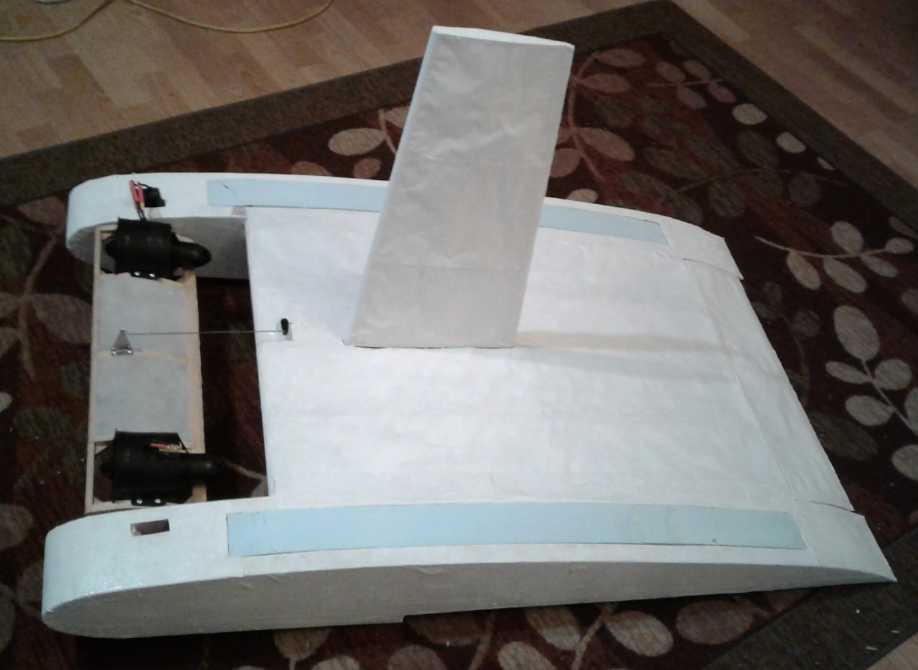 My model, pretty much unchanged for 2-1/2 years.
My model, pretty much unchanged for 2-1/2 years.
The original intended rear elevator simply became a fixed
back end of the wing when the superior canard idea came to me -
and then to put the "electric jets" propulsion on that canard.
(Details of my evolving design are in TE News issues mostly from
2018-2019.)
Now as to my own ground effect craft, particularly a
full-size
one, I have nagging thoughts about the ducted fans on the canard,
because
of course they have to be kept out of the water on a rather low wing
(at least on the model),
and the canard must transfer all the thrust from the fans to the rest
of the craft, so it and its linkages need to be very strong. A
possible solution might be to make the canard (only) a "biplane", with
the
fans sandwiched between an upper and lower canard and the pivot point
somewhere in the middle. Hopefully the pitch control trim would change
little from zero to full thrust. (I suspect it will need to ailerons
for better lateral control, too. I hope to avoid that complication in
the model.) I may also give up on trying to control the two motors
separately for steering since it isn't provided for in any radio
control system, and just slap on a rudder - which it otherwise
shouldn't need.
As for the hydrofoil idea... it might be worth checking
out! (All if I ever get that far, of course. For the time being I seem
to have completely diverted to other things.)
In conclusion an electric ground effect ferry is a
fabulous idea. I tried to make a model and may still get it flying if I
ever have time. A fast, seaworthy 'air ferry' is my ultimate goal. It
would really open up travel in island archipelagos
and along mountainous "fjord" coastlines where roads are difficult and
circuitous. But various ground effect craft that look like airplanes
have been tried and abandoned. I don't know of any operating
commercially. From what I can gather they seem to be hard to
drive/fly and are unstable especially in rough water. "Sea Glider"
prototypes may fly, but it is
probably not going to be a success.
Water as energy storage?
On youtube someone had a 50W solar panel and a small water
pump. He mounted a 200 liter barrel on the peak of his roof (7 meters
height) and
had the pump fill it during the day powered by sunshine. At night he
had a miniature
turbine use the water to light an LED light. The power available from
this considerable project was demonstrated by comparing the energy
stored to that of a single "AA" battery. To get hydro power to meet any
real energy needs a lot of water, and preferably a considerable "head"
for it to flow up and down, are required. (The 7 meters height was
good. Just a barrel of water is almost nothing. A swimming pool that
high up should provide a more useful level of energy... but maybe not
on the house roof.)
"Solar" Deep Well Pump
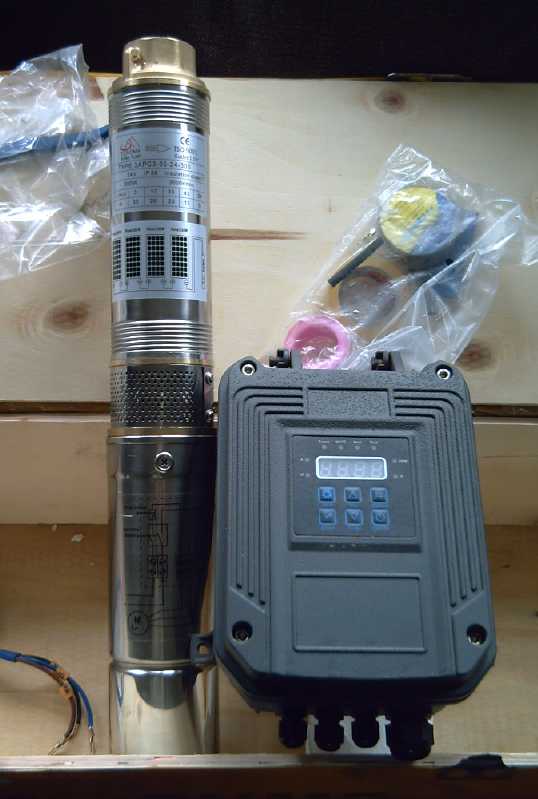 I
ordered a 24 volt DC well pump (somewhere on AliExpress.com). It
arrived on the 22nd. It was beautifully packed in plywood box with 12
metal clamps bent over to hold it shut and the whole covered in yellow
tape. It was also a great looking product, with a separate BLDC motor
motor controller that looks waterproof and a 16 page instruction book.
The book says one can power it with batteries or directly from solar
panels.
I
ordered a 24 volt DC well pump (somewhere on AliExpress.com). It
arrived on the 22nd. It was beautifully packed in plywood box with 12
metal clamps bent over to hold it shut and the whole covered in yellow
tape. It was also a great looking product, with a separate BLDC motor
motor controller that looks waterproof and a 16 page instruction book.
The book says one can power it with batteries or directly from solar
panels.
I can imagine it must pump water about as efficiently as
is possible. It's 300 watts, so 12.5 amps at 24 volts.
More LiFePO4 Battery Cells
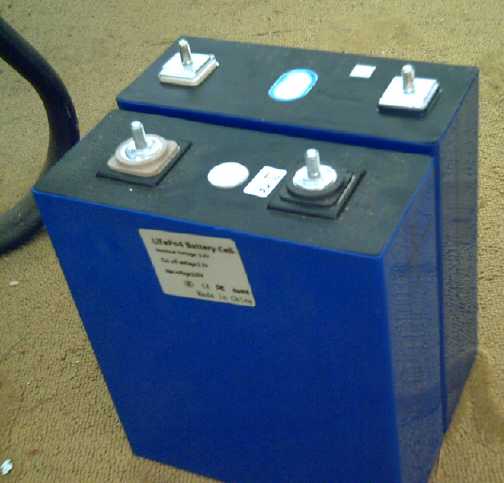 My friend Jim
at AGO Environmental Electronics in Victoria (BC) found a place in
China to import 302 amp-hour cells from, and he bought a considerable
batch of them. I bought four from him, which I can use either in
parallel for an extremely high amperage HHO torch system power supply
(3.6V), or in series as a 12 volt battery.
My friend Jim
at AGO Environmental Electronics in Victoria (BC) found a place in
China to import 302 amp-hour cells from, and he bought a considerable
batch of them. I bought four from him, which I can use either in
parallel for an extremely high amperage HHO torch system power supply
(3.6V), or in series as a 12 volt battery.
Recently I had also got four direct from China myself, 280
amp-hours. They took months to come. (The seller explained that they
were stuck in a ship off the port of Vancouver, which was very
backlogged owing to the flooding the previous spring.)
Anyway, in comparing the two they certainly seemed to be
made in the same factory. The 302 amp-hour ones had the terminals
farther apart, were about 5mm taller and a pound or so heavier. "+" and
"-" were not very well identified on either set. Use a voltmeter!
In
Passing
(Miscellaneous topics, editorial comments & opinionated rants)
Everybody's
Garbage
Problem
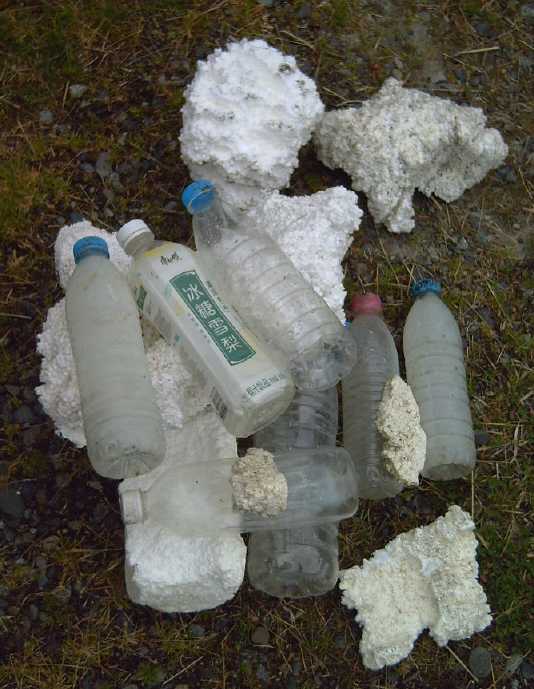 When I go for
a walk on the beach when the tides run higher (new moon, full moon),
and if I chance to venture up near the high tide mark, I usually find a
bottle or two... and some disintegrating polystyrene foam... and more,
and more, and I sometimes come home with an armload - all I can carry
without having brought a bag, even for a few days in a row.
When I go for
a walk on the beach when the tides run higher (new moon, full moon),
and if I chance to venture up near the high tide mark, I usually find a
bottle or two... and some disintegrating polystyrene foam... and more,
and more, and I sometimes come home with an armload - all I can carry
without having brought a bag, even for a few days in a row.
This is the "pristine" northern BC coast where few people
live. Should and would there be any cleaner beaches anywhere in the
world? Beaches everywhere where no one lives to clean it up are
probably just rolling with plastic junk.
I've seen videos of garbage trucks backing up to the edge of a bridge
and
dumping garbage into the river, one after another after another. From
there of course it flows into the sea. From there, Asia's garbage
problem becomes everyones' garbage problem. Especially if you live by
the sea. Most of these, having no remaining labels, might be passed off
as North American "local" garbage with nowhere to point the finger and
no doubt much of it is, but
how much of it drifts across the Pacific from the other side?
USA:
"Civil Service" Run Amok
In the USA, civil servants are protected by civil service unions. The
president can't fire or dismiss them. But many unelected officials have
a big say in determining or influencing US policies, including foreign
policy. This (along with many other things) gives the established
oligarchy great power over the people's elected representatives. Thus
they hamstring any attempts by those elected to make changes unwelcome
to themselves or their sponsors (the military industrial complex, the
big corporations, the big banks, big pharma, big ag, big tech...) - to
"drain the swamp", so to speak. Policies decreed by unelected officials
and set in motion hampered both Obama and Trump (not to mention other
previous presidents) in their attempts at reforms to set national
policies more in line with what Americans wanted. The bureaucracy,
accountable only to itself, has in large measure seized the reigns of
government and it is small wonder that it doesn't seem to matter who is
elected any more - and most of the candidates are vetted and approved
by this same "deep state" in the nomination processes. What a great
perpetual gravy train!
Not long before leaving office Trump started to see what
these arrangements were doing and signed an executive order declaring a
"Schedule F" category of civil servants who would not have civil
service union protection owing to their positions as policymakers and
influencers. The president would have the power to dismiss "Schedule F"
civil servants. The order demanded a thorough review of the whole civil
service to see who would qualify. It looked like it would be a large
number. This would in theory have gutted the power of the unelected
Washington establishment and returned it to elected administrations.
Small wonder then that the entire oligarchy was so desperate to eject
Trump from office in 2020 by every means moral and immoral, legal and
illegal, however brazen. (The mass media is part of this oligarchy and
has repeatedly told us that nothing untoward had happened. The election
fraud and irregularities uncovered in various states since the election
also receives no coverage.)
Biden reversed this landmark reform immediately on
assuming office. There is probably no hope of meaningful reform in the
USA now without a complete collapse of the government. This is probably
coming.
Russia
&
Ukraine Again (oh no, not again!)
* Pierre de Gaulle, grandson of Charles de Gaulle, gave a rather
scathing condemnation of France's role in the Ukraine conflict,
in submitting to NATO and the aggressive American policies which "seek
to
divide Europe", speaking at a well attended reception at the Russian
embassy in
Paris on "Russia Day". He mentioned the overlooking of militancy and
nazification of Ukraine by the West and said it was in France's
interest to have good relations with Russia.
Naturally, this was not reported in Western media,
apparently not even in France. (I saw it on rt.com - French) Western
media is doing a great job of
painting the West White, Ukraine White and Russia Black.
* News reports here had it that Donetsk was being shelled by Russian
forces,
who targeted even a maternity hospital. Reporting that Russians were
assaulting their own allies' capital is more than just a mistake. It is
a lie, propaganda pure and simple, counting on confusing people
unfamiliar with names, events and places to demonize Russia. The
Ukrainians have been dug in and strongly fortified just north
and west of Donetsk since 2014 and of course that's where the artillery
shells were coming from. (Why? at this point is another question.
Diversion?)
* To say that there are a lot of Westerners who look at this conflict
and
entirely disagree with the line their own governments have taken, would
be an understatement. Of course, they are reluctant to speak up owing
to the majority having swallowed once again the narrative the mass
media has been feeding us, and who are unwilling to believe that our
once proud, candid and free media has become a programmed part of a
propaganda
machine. No other views (and no unwanted topics) are to be given any
publicity or credence.
(Walter Cronkite must be rolling over in his grave!)
Those who call for unity need to be on the side of truth
and good and fairness. Unity can't be had by deceit and manipulative
machinations with hidden agendas and goals. Only Russians have become
more unified by events, and more and more indignant at the Western
world.
* "Most corrupt nation in Europe" Ukraine continues to fight and to
lose territory, and they continue to incite the strongest adverse
reaction from Russia and Russian speaking people that they are able.
They have made the Russian language illegal in schools when half
their population speaks Russian, and now banned Russian books and
music. I understand they
have also, having taken their assets some years ago, thrown opposition
party leaders in jail. Some democracy! What Russian speaking person in
Ukraine would want to remain loyal to such a government? Are they not
igniting more bitter internal sentiment likely to lead to further
separatist
actions, for
example in Odessa and Kharkov?
* Russia has offered to give safe passage to grain ships
wishing to ship Ukrainian grain, to help the nations where there is a
fast developing food crisis, and even to send its minesweepers ahead of
the grain ships. But Ukraine doesn't want to lift the sea mines in
front of its
ports in case Russia might try a seaborne assault on one or more of
them. The West wants to send warships into the Black Sea to protect the
grain ships - an escalation toward a truly deadly third world war.
Putin has suggested that another simple way to get
Ukrainian grain out would be to ship it by train to the Baltic via
Belarus and Lithuania. (It can't go through Poland easily owing to
differing railway gauges.) The UN is just hemming and hawing about that
plan, too.
Russian and Greek ships carrying grain from the Black Sea,
which the Russians say is theirs but which Ukraine asserts is stolen
Ukrainian grain, have been stopped in Turkey. (I'm describing at least
two separate incidents and am blurring some details. The point is that
the grain seems to be being stopped rather than delivered.)
The UN and the West throw all the blame on Russia (for a
crisis that was already developing in 2021 but obviously made worse by
events), but are
they really sincere about wanting to get Ukraine's food to the needy?
Russia has said it is not now going to give Zaporizhia or
Kherson regions back. First, the land route through Donbass to the
Perekop neck of Crimea is through Zaporizhia and the southern edge of
Kherson.
Then, in Soviet times if not before, a canal was made from
the Dneiper river through Kherson, across Perekop and into Crimea to
provide water to the once rather dry peninsula. When in 2014 Crimea
(mostly Russian speaking) voted to separate from Ukraine, and then to
rejoin Russia (90+% "for"... which the West calls an "annexation" of
Crimea), for spite Ukraine blocked the water just short of the border.
Russia has reportedly spent a billion dollars shipping water to Crimea
since then.
What incentive does Russia have to relinquish these
hard-won territories which are more geographicly valuable to them than
to Ukraine as well as having a majority of Russian speaking residents,
and give them to a Ukraine that seems to hate half their own people so
much as to deny them their own language, and to deliberately cut off
plentiful, freely available water to those who need it? Ukraine having
never honored the Minsk accords it signed in 2015, not having
negotiated peace when it would still have been advantageous and having
done these hateful, spiteful things, it would surely amount to a
betrayal of the Russian speaking majorities in Zaporizhia and Kherson
to give - to abandon - them back to Ukraine's tender mercies, as well
as allowing
Ukraine to cut off the water to Crimea again. And within these areas
Russia is more being welcomed as a liberator than seen as an
invader.
Russia has, after three decades of trying to get along,
also now pretty much given up caring what the West thinks about
anything, too. The West certainly hasn't cared what Russia thinks for a
long time. I think that is a shame when Russia has come so far from
monarchy and then the horrible communist era into liberty with
representative democratic government and a free economy, which one
hopes may continue to develop and mature after the current brilliant
and now long-time president is gone from the scene. (The West OTOH
seems to be transforming itself a dictatorial oligarchy with a
democratic façade.) Having been kicked out of the "G8", Russia
is forming a new "G8" economic block with China, India and others (eg,
Iran, Argentina) who are applying to join, the "BRICS" (Brazil, Russia,
India, China, South Africa). The
"West", I hear, has 15% of the world's population. This new block will
represent much of the other 85%.
I think Ukraine has "lost the plot". Either that or
Zelensky truly was affronted and alarmed in 2019 when he was elected
(on "Peace in the Donbass") and went to visit the Azov battalion, and
when
he said "I am your president", they laughed at him. They may have
reminded him of the politicians who disagreed with their agendas who
have been
murdered so far. Perhaps he saw that there was no way to govern the
country with these "state within a state" forces on the loose, and he
actually goaded Russia deliberately into attacking in order to
eliminate them, almost regardless of cost to the nation. Certainly his
statements prior to the invasion about "renouncing Ukraine's
non-nuclear status", "joining NATO" and wanting the Donbas and Crimea (and
Crimea?!?) back, and moving these same extremist militaristic
forces into position to attack them, could hardly have been more
provocative and demanding of Russian action. And the obstinate refusal
to seriously negotiate peace so far may be because there are still a
lot of them left. When the Russian allied forces have finished
eliminating the neonazi organizations, which are mostly in he Donbass,
perhaps then Zelensky will want peace.
But if this is true, he is certainly playing a very fine
double game, convincing the West to send more and more resources to
keep up the morale of the extremists so they don't give up the fight,
as they are gradually beaten out of the territories they have
terrorized for 8 years, village by village, town by town, city by city,
by a well armed and supplied Russia and the Donbassians that are
suffering very light losses
and are thought to have fewer men in the field than Ukraine does. (And
it would seem many of the weapons supplied are ending up on the "black
market" for use elsewhere.)
In a fair and
sweeping general referendum, I have a feeling Ukraine would lose still
more territory to Russia, and probably in the west to Poland. Maybe
even to Romania, Belarus and Moldova. (Before WWII part of what is now
Western Ukraine was part of Poland. Stalin moved it. Lvov was Polish.
Journalist Pepe Escobar has said it's a "Polish wet dream" to reoccupy
that area.)
Would there or will there or should there still be a Ukrainian state,
and consisting of which oblasts/provinces?
But the West as a whole also seems to despise Russia and
everything Russian. Against all we claim to stand for we provide
weapons and pay to violent neonazis (the "state within a state" in
Ukraine), supporting them to inflict harm on Russian speaking people
since 2014. The head of NATO, Stoltenberg, let slip at the recent NATO
summit that that was the plan ever since 2014 if not earlier. When
Russia finally acted to protect and free the oppressed
in February 2022, we put all the long planned (but apparently
ill-conceived) "sanctions" into effect against it. Now Lithuania wants
to prevents goods from going from
the main part of Russia to the disconnected Kalingrad part of Russia
through its territory, in violation of agreements made 30 years ago as
a condition for Lithuanian independence and in effect ever since.
The Soviet Union and communism were worth fearing and
hating. Communism in its early decades believed it was "manifest
destiny" that communism should rule the world, and that "the ends
justify the means" ("means" including fomenting violent uprisings and
starting major wars.) Well, means are ends in the making, and such an
aggressive ideology is long gone even within "Communism".
Why today should we still
treat Russia after 3 decades of progress in fostering democracy,
economic growth and liberty as if it was an evil ideological beast
seeking world domination, according it hateful, discriminatory
treatment we would say was unfair and unjust if it were accorded to any
other nation doing similar things? We don't even treat autocratic China
(purge against its own Uighur peoples), Soggy Arabia (bombing Yemen for
years now) or other
dictatorships with such disdain. Are we against democracy?
* On July 3rd Lugansk announced that with the support of Russia's
forces, it had liberated all of its territory. One of the objectives of
Russia's "Special Military Operation" has been achieved. One suspects
the Donetsk territories still occupied by the neonazi brigades will
follow.
Smol
Thots
* I had switched from spraying & rubbing alcohol on my scalp from
weekly to
monthly. I might have missed a month. A brief dream or vision of
baldness came to me as I
was waking up one morning. That convinced me to go back to every
Saturday.
* Why is it that left handed people need right handed scissors to cut
their toenails, while right handed people need left handed scissors?
* Why aren't left handed scissors more common when so many people are
right handed?
* No need to ask why right handed people buy special toenail clippers
when it's so hard to find left handed scissors.
* Some people have been saying that renewable energy is no solution to
our energy needs. Indeed, what keeps happening is that as we finally
have started making more and more renewable energy, the population
still keeps on expanding. (And homelessness just keeps on growing as
more
and more housing is built.) As the total energy requirements go up for
more and more people, we need just as much non-renewable energy as we
did before
or even more. The truth is that none of our biggest problems can be
solved until the
ever-growing population problem is solved. But present conditions
suggest that it is about to be solved involuntarily in spite of
anything we can do.
In the 1800s and early 1900s our food production,
medical and
health standards and techniques improved dramaticly, leading to a huge
reduction in tragic premature deaths of all kinds (war deaths
excepted). Ideally that would have been
accompanied by a corresponding reduction in family sizes. But since,
globally, we didn't curtail population growth after
we hit 3 billion people in 1960 or after the birth control pill became
widely available a few years later, nor at any time following,
exponential
growth was bound to bring us to the end of the planet's resources
needed to sustain far too many lives. As someone put it, we would need
2-1/2
Earths to sustain the present population. Or, if the craziest of dreams
could magicly come true and we shipped half the population to
"terraformed" Mars,
both planets would already be overpopulated.
After 1965-1970 or so, as competition grew and quality of
life dropped, "Western" lands started having smaller families and the
birth rate dropped sharply. I thought that was great, that whatever
happened in the "Third World", the more developed lands at least would
be stable. Instead, our short-sighted leaders saw all those excess
people from other lands as sources of cheap labour and started
importing them by the millions, year after year, decade after decade.
Even when the phenomenon of epidemic homeless people began in about
1980-1982 the
policy was unchanged: import more people!
In most lands those peoples who had achieved and
maintained higher standards of living and culture continued to be
squeezed by the ever increasing competition for land and housing and
responded by having even smaller families or no children. Not only
would our populations rise and rise along with those parts of the world
still having far too many children, but we who built these cultures
have become minorities most everywhere in our own lands. And "culture"
seems to be going by the wayside as life becomes cheap.
But perhaps the more violent and antisocial, the sadly
inferior and the social predators of all races will tend to be
eliminated in large proportions in the coming hard times, while the
more discerning, more insightful, more reasoning, more patient, more
social, more spiritual and more willing to serve will tend to survive.
"The moderate [or 'meek'] will inherit the Earth." said Jesus. The
quality of world civilization is ultimately determined by the quality
of its people, and losing much of the lower strata may bring the
promise of a utopia much closer to realization. One can only pray and
have faith that "No doubt the
universe is unfolding as it should." as Pierre Trudeau once put it.
ESD
(Eccentric Silliness Department)
* Besides a couple of subtle letter changes, what is the difference
between
"cooperation" and
"corporation"? How close are they
to being opposites?
* Why do crescent wrenches always adjust in the direction opposite to
the one you try first?
"in depth reports" for
each project are below. I hope they may be useful to anyone who wants
to get into a similar project, to glean ideas for how something
might be done, as well as things that might have been tried, or just
thought
of and not tried... and even of how not to do something - why
it didn't
work or proved impractical. Sometimes they set out inventive thoughts
almost as they occur - and are the actual organization and elaboration
in writing of those thoughts. They are thus partly a diary and are not
extensively proof-read for literary perfection, consistency,
completeness and elimination of duplications before
publication. I hope they may add to the body of wisdom for other
researchers and developers to help them find more productive paths and
avoid potential pitfalls and dead ends.
(No Reports)
Other "Green" & Electric Equipment Projects
Gardening
As usual I just did some not very innovative food gardening. Again
quite a lot of it, but I didn't think to write much about it as I
worked. (Anyway there's lots of good
gardening channels on youtube! - Pay attention to the different
climates the presenters are growing in and find those that
approximately match yours.)
But here are some pictures. Lots of potatoes are growing
nicely. (so
is the grass between the rows.) If there really is a food crunch,
potatoes is
the simple "calories" crop to keep one going. I have white ones, red
ones, plus (meat and skin) purple ones, pink ones and maybe some yellow.
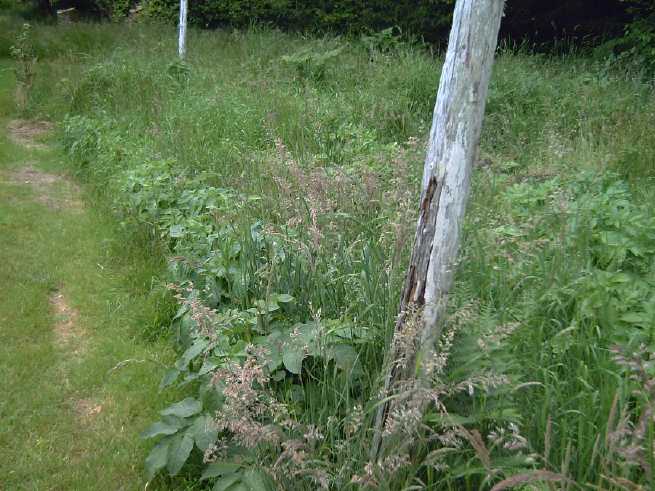 The "old garden" plot with 3-1/2 rows of
potatoes 25 feet long and grass growing tall between and beyond.
The "old garden" plot with 3-1/2 rows of
potatoes 25 feet long and grass growing tall between and beyond.
I considered it too shaded to grow anything until I cut down 3 trees
just south of it this spring...
then I said "It's probably bright enough there now for potatoes!"
Luckily the deer don't seem to care for potatoes and I can grow them
outside of fenced areas.
 "Potato Hill" next to the main garden - an 8 by
9 foot patch that started as volunteers in a pile of dirt.
"Potato Hill" next to the main garden - an 8 by
9 foot patch that started as volunteers in a pile of dirt.
I "fluffed up" the dirt with a shovel this spring as potatoes grow
biggest in loose soil.
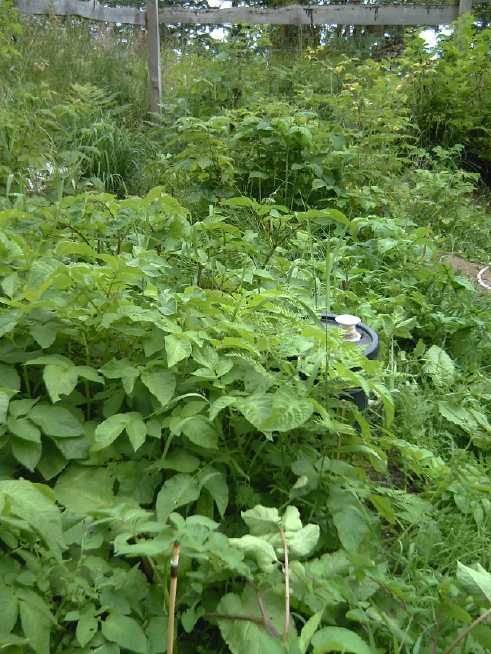 The north side of the main garden with (yes)...
more potatoes.
The north side of the main garden with (yes)...
more potatoes.
Beyond them, raspberries. (hidden in there somewhere, a few other
vegetables.)
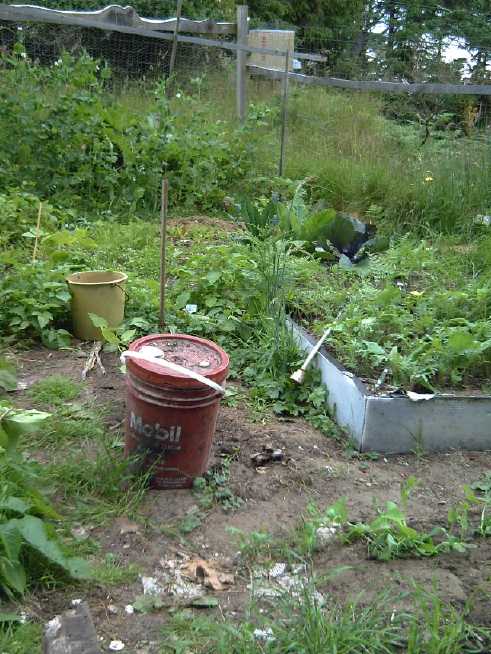 Ssouth side of the main garden.
Ssouth side of the main garden.
Farthest back, black currant and josta bushes and a giant rhubarb
are hidden behind a tall 10 foot long row of peas. (The birds have been
eating the berries. If I want any I'll have to cover them.)
In front of the peas besides profuse weeds (including potatoes) are
various vegetables: beans, lots of carrots, kale (volunteers!),
cabbage, turnips, radishes, beets...
Front right a new row of peas. (nothing for them to climb on yet!)
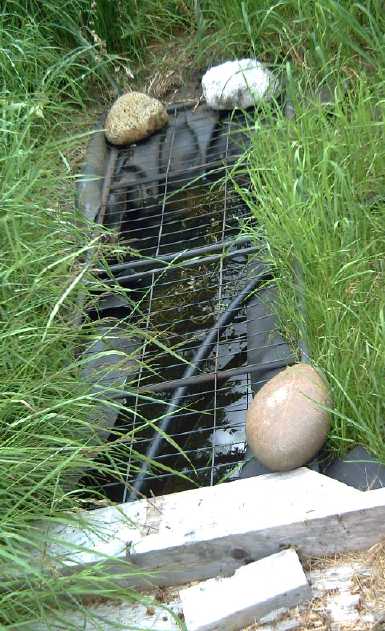 I made a new "hidden" pond next to the garden.
I made a new "hidden" pond next to the garden.
I used a small pond liner (and "Ikea sofa back frame" guard to keep the
otters,
raccoons and herons out), both brought from Victoria when I moved.
3 tiny "pond comet" goldfish for just 17.50$ each.
(They have to be rushed air freight, couriered at both ends: "It's the
water they're in that costs a fortune to ship."
She said they were cheaper when someone on the island was raising
them... but an otter got those.
An otter got mine twice in Victoria. They catch and eat them all in one
sitting.)
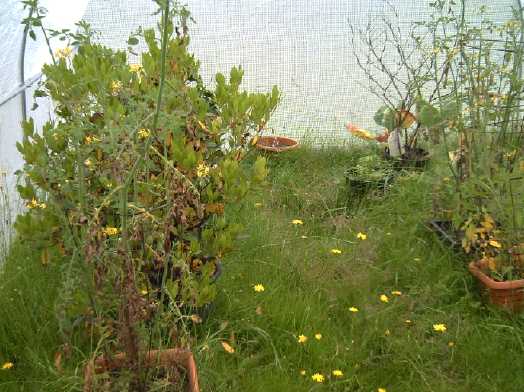 I bought a 10 by 15 foot tube frame &
plastic cover greenhouse
and put my potted
I bought a 10 by 15 foot tube frame &
plastic cover greenhouse
and put my potted
plants in it to make more room in the main greenhouse.
But something (leafhoppers in the grass?) was eating the peppers
and I had to put them outside on my porch, despite peppers liking heat.
 The corn in the main greenhouse. A few of the
plants are doing much better than the rest.
The corn in the main greenhouse. A few of the
plants are doing much better than the rest.
(Why? Hmm... The seeds were of more than one variety. I'll save some
from the
big ones - assuming I get cobs!)
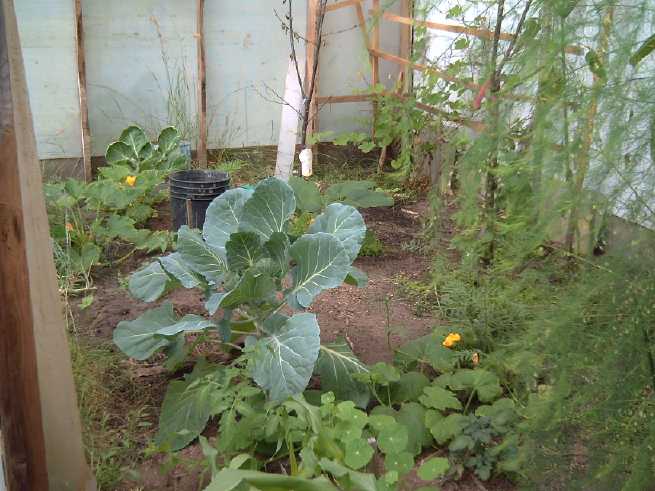 The other end of the greenhouse.
The other end of the greenhouse.
Zucchini, squashes, tomatos, beans, a big volunteer cabbage or broccoli
or cauliflower. (not sure yet!)
Fruit trees not doing well (got dried out over winter when I forget to
water?), grape vine not
as bad.
Asparagus jungle is to my right.
 Squash plants seem to just sit there, then
suddenly they start running along the ground and occupying
Squash plants seem to just sit there, then
suddenly they start running along the ground and occupying
more and more space. I finally found why the edges of the leaves turn
yellow: potassium deficiency.
I guess I should mix in more woodstove ashes when I'm planting?
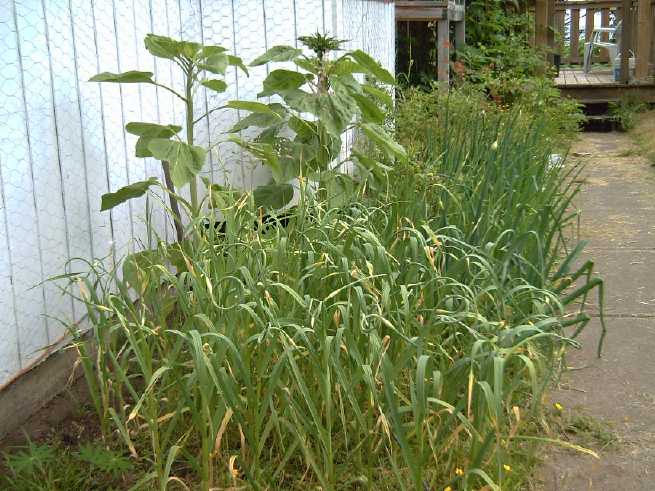 House south wall garden: garlic planted last
fall, sunflowers
House south wall garden: garlic planted last
fall, sunflowers
started in pots in spring, many & various onions, chives, mint, 5
blueberry bushes.
Strawberries (a variety that actually makes berries here!) are under
camera.
The birds seem to have just discovered them and I'll have to cover them
if I
want any more berries.
[15th] After overnight soaking, I sprinkled kamut wheat seeds on
the lawn near the chicken coop. I then used the pressure nozzle on a
garden hose and blasted the ground where the seeds were. Hopefully some
will have dug in a bit and start growing. I used about 2 cups of seeds.
[21st] The deer have been going through there eating everything. If I
don't get fences up, there will be no barley or wheat. (Finally done
early July.)
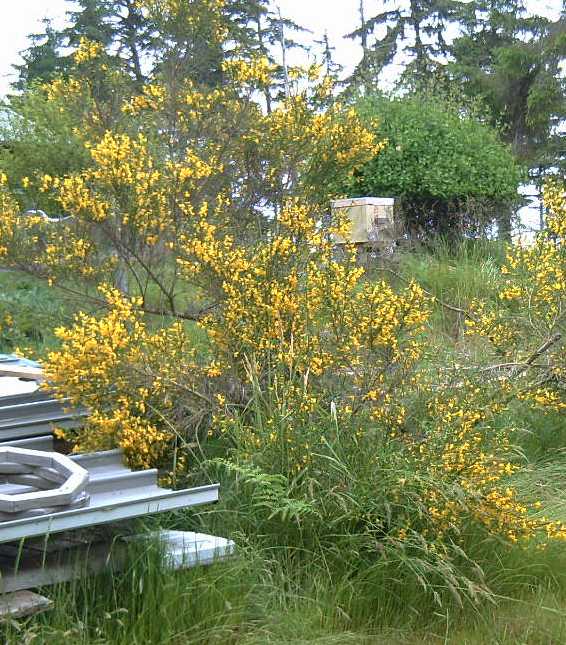 [19th] My bee palace is
still sitting out there empty. But as I
approached a scotch broom bush, it was buzzing. The buzzing subsided.
It seemed my approach had spooked the bees and they had left. I only
got a glimpse of part of one in a flower on the far side before it too
departed. They were either quite small bumblebees or honeybees.
[19th] My bee palace is
still sitting out there empty. But as I
approached a scotch broom bush, it was buzzing. The buzzing subsided.
It seemed my approach had spooked the bees and they had left. I only
got a glimpse of part of one in a flower on the far side before it too
departed. They were either quite small bumblebees or honeybees.
It occurred to me that if honeybees were living farther
inland
on this island, away from the cold sea breezes, if anything would
entice them to come visit down here by the shore, it would probably be
the broom flowers!
Next day I got a better look. They were small bumblebees.
[July 2nd, 3rd] It was sunny and warm, and this time there were a few
actual
honey bees! They had a higher pitched buzz than the bumble bees. I
guess if there's a swarm I have a chance they'll find my hive.
[July 7th] It belatedly occurred to me to smear a little honey onto
frames inside the beehive. A smell to attract them. Hopefully there'll
be more warm days with honey bees around!
I think some of my crops are suffering a lot from there being so
few honey bees around - like just a few apples (or often none) on trees
that should be producing
in abundance by now. (At least there are a few this
year, after
planting a third tree and all my efforts at hand pollination!)
 Upper: Flowering broom with bee palace on hill
behind.
Upper: Flowering broom with bee palace on hill
behind.
Lower: Yellow, deep red and two-tone flowering broom.
Plastic Recycling 2.0
Big Oven
Inevitably when I assembled another new chemistry battery
cell, everything else fell by the wayside for a while. But I wanted to
get back to this.
[21st] I cut the inner, foam insulated
lid as it was slightly longer
than the original lid. I took out a couple of inches of the foam
insulation and bent the metal end over to form a new edge, in
order that it would fit just inside the original lid all the way around.
[22nd] I finished prepping the inner lid, removing plastic bits and
stuffing foam in holes and gaps where pieces had been. Then I bent the
underhangs on the original lid out to vertical, so that the other lid
would fit just inside.
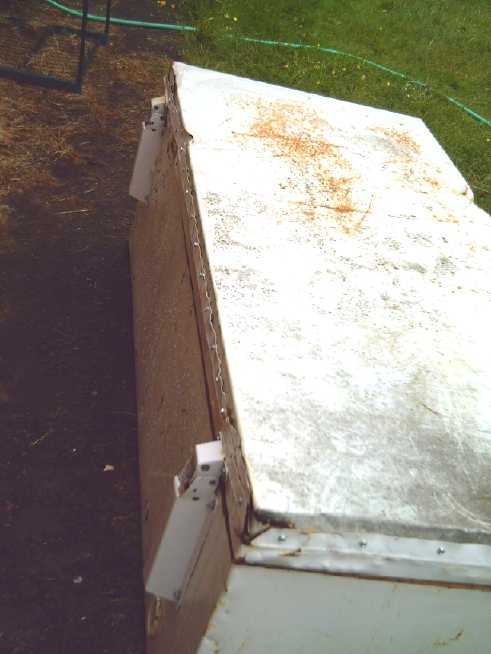 Then I decided
to use them the other way around: the
original lid facing down into the oven with its vertical edges all
around facing up and with its original fiberglass insulation inside.
Then the foam insulated lid would go metal side up on top of that. So
it would still have metal inside and outside. I figure the fiberglass
is the best insulation for the inside. The one drawback is that instead
of rain running off, it would want to fill the inside of the lid. I'll
have to keep it dry. I probably would have to/want to anyway. I screwed
the two together with "self drilling" sheet metal screws.
Then I decided
to use them the other way around: the
original lid facing down into the oven with its vertical edges all
around facing up and with its original fiberglass insulation inside.
Then the foam insulated lid would go metal side up on top of that. So
it would still have metal inside and outside. I figure the fiberglass
is the best insulation for the inside. The one drawback is that instead
of rain running off, it would want to fill the inside of the lid. I'll
have to keep it dry. I probably would have to/want to anyway. I screwed
the two together with "self drilling" sheet metal screws.
I did my best, but the lid still being anything but flat
and straight there's some fair gaps around the rim. Since they are
irregular and it will get hot I'm not sure what to do about those other
than staple on some fiberglass or rock wool onto the body piece all the
way around. (Yuk!)
[30th] I started wiring the temperature
control and heating element
components. (The little control goes in the big space at the left end.)
I got to the point where I wanted a terminal block to tie
down the 230V wires. (the one from the original oven.) I couldn't find
it and the work session devolved
into a frustrating search. (I finally found it in some clutter on July
4th - right where I had thought it was but didn't see it for looking.
Clutter, clutter... but if I was a "declutterer" I'd have thrown
the strip out with the oven instead of keeping it in case it would be
useful... and the other potentially useful things in that pile
that I may or may not ever use. Still, it seems to be getting out of
hand.)
Lawn Grass Wall
Insulation!
In investigating eel grass insulation, scanty information
seemed to suggest that lawn grass had a higher "R" value. That probably
makes it better than most any wall insulation except extruded
polystyrene or
polyurethane. So it'd make for the lowest heating bills of anything
affordable and it's "green" (so to speak) and free for the cutting and
drying, no itch or health hazard, and is easily recycleable someday
when the building comes down. I have an acre+ to mow and a lawn
tractor. And a rake. I got some woven plastic bags, which "breathe".
That way if the grass isn't totally dry when I bag it it'll continue to
dry, not sit and moulder. I let the grass get pretty tall before I
mowed it. (One might just call the product "hay". or even use it as hay
if you have sheep or cows. But "hay" is usually not chopped up so fine,
the grass stalks being kept full length in the mowing.)
After I mowed part of the lawn and let the cut grass dry
in the sun (or clouds!), I put some of it on wire racks under cover to
get still drier. Then I bagged it somewhat loosely, stuffing it in but
not very hard. That way it wasn't crushed down and had air space to get
it drier. (I may skip the "drying racks" step if the grass is pretty
dry to start with, and just bag it. Grocery store big onion bags,
chicken feed bags, grain bags...)
 [21st] It still needed a
test, and I needed to estimate how many bags I
would need. I stapled some plastic up to about 5 feet from the base of
the wall studs in the cabin. I took a bag of the dried grass and
"fluffed" it as I poured it loosely into the 16 inch centers wall
space. It filled nicely. It took about 3/5 or 2/3 of a bag to fill that
space.
[21st] It still needed a
test, and I needed to estimate how many bags I
would need. I stapled some plastic up to about 5 feet from the base of
the wall studs in the cabin. I took a bag of the dried grass and
"fluffed" it as I poured it loosely into the 16 inch centers wall
space. It filled nicely. It took about 3/5 or 2/3 of a bag to fill that
space.
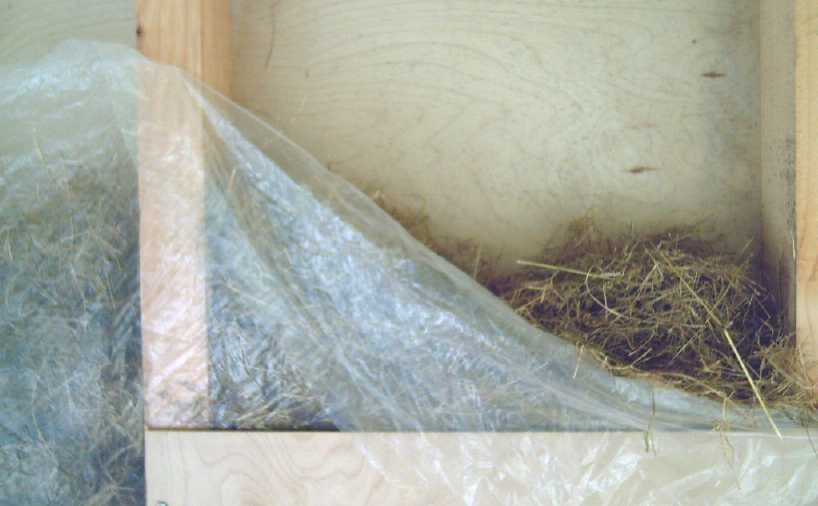 But the
plastic bulged out considerably. I screwed a piece
of plywood over the next stud and filled it up to over 4 feet high. It
took less than the remaining grass in the bag. So it might be one bag
per 12 foot tall wall stud, which suggests I'll need around 100 bags of
grass. At the rate I've been working on the cabin, I have at least 2
summers to collect all that grass!
But the
plastic bulged out considerably. I screwed a piece
of plywood over the next stud and filled it up to over 4 feet high. It
took less than the remaining grass in the bag. So it might be one bag
per 12 foot tall wall stud, which suggests I'll need around 100 bags of
grass. At the rate I've been working on the cabin, I have at least 2
summers to collect all that grass!
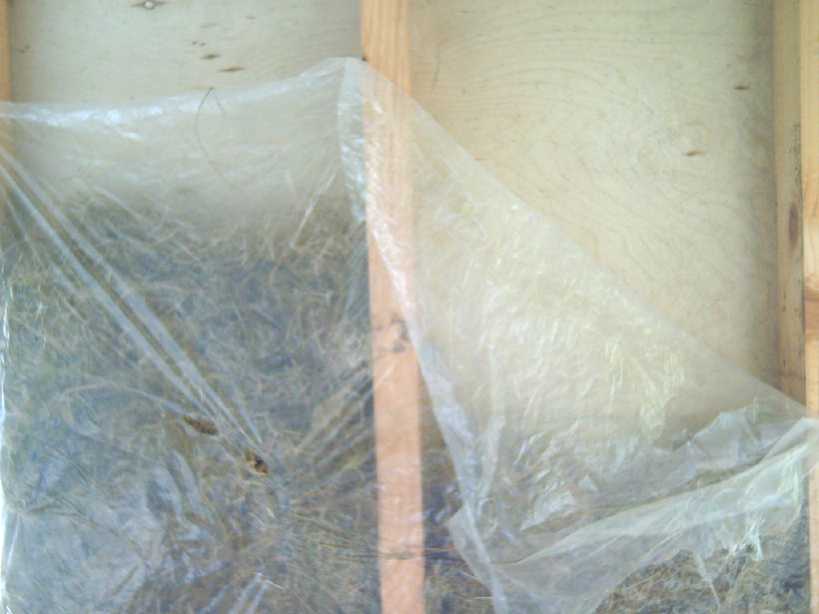 When I
unscrewed the plywood the plastic bulged out and
the loose grass settled into about 3/4 of the height. I have the
impression that if it's just slightly patted in at the top, it all goes
down a bit. I think it won't settle further and leave an uninsulated
gap at the top.
When I
unscrewed the plywood the plastic bulged out and
the loose grass settled into about 3/4 of the height. I have the
impression that if it's just slightly patted in at the top, it all goes
down a bit. I think it won't settle further and leave an uninsulated
gap at the top.
I won't use plastic ("vapor
barrier") behind the gyproc walls. The outside
walls are thin plywood, an air space, and the alume siding. I think
with the gyproc inside, the
tiny natural amount of circulation in that should keep the wall space
dry, and that it should "breathe". (And the fluffy, loose grass is
still less likely to settle
against the slightly rough gyproc than against smooth polyethylene.)
For the attic/ceiling I have already bought fiberglass
batts. I don't want exposed grass anywhere. It should be plenty safe
sealed inside the walls. I will also surround electrical boxes in the
walls with a piece of fiberglass batt.
[28th] The efficacy of grass at stopping air flow is demonstrated by
the fact that if you have a fluffy layer 3 or 4 inches thick, the grass
at the top dries, but an inch or inch and a half down seems to be just
as wet days later and it starts going mouldy. So drying the grass in
wire racks under cover turned
out not to work so well. I had to keep turning it to put the wettest
grass on top, and it was taking many days. While not entirely
impractical for small quantities, it would seem the easiest way is to
mow it and leave it where it lies to dry in the sun -- and hope for
sun. Thus the saying "Make hay while the sun shines." is literally very
true. For a big field of grass/hay any other way of drying would
require heat and ventilated air with the grass being tossed around or
otherwise circulated, which be very energy intensive and probably with
lots of dust coming out.
A neighbor was mowing a lawn on his lawn tractor and
collecting the grass in a catcher. It turned out he was just dumping
it, so I had him dump it on my lawn, and I spread it out to dry.
Spreading out grass from a
pile next door to dry in the
sun.
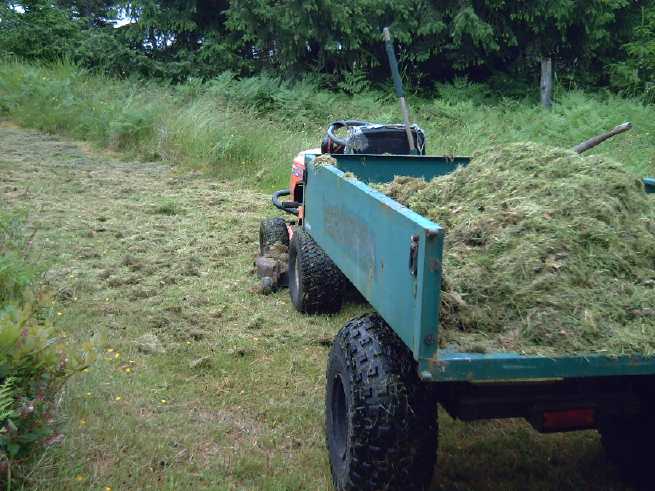 [29th] I chanced again to
talk to my neighbor. He mentioned
that if I
wanted more he had dumped it in the bushes in a certain place and that
I should take my lawn tractor over there with the trailer. I had doubts
about collecting anything but the latest mowing, but he had spread it
out, dumping in an area rather than one tall pile, and I got a trailer
full.
I again took it and shook it out over a wide area of my lawn to dry.
(Now if only the sun would come out!)
[29th] I chanced again to
talk to my neighbor. He mentioned
that if I
wanted more he had dumped it in the bushes in a certain place and that
I should take my lawn tractor over there with the trailer. I had doubts
about collecting anything but the latest mowing, but he had spread it
out, dumping in an area rather than one tall pile, and I got a trailer
full.
I again took it and shook it out over a wide area of my lawn to dry.
(Now if only the sun would come out!)
In doing that, in addition
to the unexpectedly apparently poor air
circulation within loose grass, the almost "ephemeral" light weight of
dry loose grass suddenly made me think of silica
aerogel, and I started wondering if it might be even
better insulation than I had expected. From a table on Wikipedia the
best insulator is a "vacuum plate" (R 14-60), silica aerogel is R-10,
and urethane, styrene and other closed cell foams are in the range of
about 5.5
to 7. Fiberglass is about R3 to 4.
What if grass was R- 6 or 8 or even 10 per inch? R-10 would give R-35
in a typical "2 by 4"
stud wall! (Fiberglass batts give R-12.) Wouldn't that be a
incredible?!? R5 would give the 2 by 4 wall R-18... so why make fat 6
inch thick walls?
And if the open loop air heat pumping (When I or somebody
gets it working well - TE News issues around spring 2020) is able to
provide a COP of 10 or so, giving 1000W of heat for 100W of
electricity, the cost to heat a house (measured in energy or money)
should be quite low.
The way to find out relative insulation values for sure
would be to run some
controlled tests. As if I needed another project on top of all my other
projects besides just pouring it into the walls of the cabin! But at
present I don't think any such tests have ever been done and so using
dried grass as wall insulation is a total wild card. It seems like
something worth doing.
[30th] I had thought of making a miniature plywood structure with inner
and outer walls, with a 2 inch air gap between on all six sides, and
insulating it with the materials to be tested. Then I would put a 25
watt light
bulb inside and see what temperature it rose to compared to the room
temperature. Overnight it occurred to me it would probably be easier to
just use cardboard boxes - if I could find two the right sizes. Rats! I
had a large and growing stack of them and I just finally burned them
all a week ago. How
does it "always" seem to work out that way? But cardboard is easy to
slice and tape pieces together, too. Pick one box (I already have a
couple of new ones) and cut and tape to make the other.
[early July] I ran some quick tests in cardboard boxes that seemed to
show grass was good insulation, but not fantastic. (More next month.)
Also my neighbor mowed again an brought over a small
trailer stuffed full behind his quad. We spread it around. I seem to be
having trouble finding more bags, and the sun hasn't shown itself much
to dry the grass on the lawn. (I have 32 bags as of writing.)
Electricity
Storage
Gelled Nickel-Zinc Batteries (take: 30 or 40)
Idea
[13th] Having discovered last month that
external flat metal end clamp sets were used to hold set of flat
lithium cells with weak faces and prevent them from bulging (in fact,
ballooning out), I decided to try again to make flat gelled Ni-Zn cells
and use that technique, since I had had some success with them
previously, but they weakened as the faces bulged out, expanding the
powder/paste electrode materials so they conducted poorly.
Planning
Having had such limited success with nickel manganates
+odes (so far), I decided this one would just be pieces of NiOOH from a
Ni-MH "D" cell. And while cupro-nickel had mostly seemed to work as a
current collector, in one "recent" cell the terminal had corroded off
at or above the water line. So this time I would use graphite sheets.
I now had two ideas for zinc -odes: one was to
electroplate copper foil with zinc as before, but then to run the
spongy plated sheets through the rolling mill to press the zinc firmly
onto the copper. The second was to electroplate graphite felt with zinc.
The graphite felt idea seemed a bit "iffy". It would make
an electrode with a high surface area and hence capable of very high
currents, but just flat zinc is quite good without embellishment. And
it seemed to me that if it had a super high surface area, it would take
an awful lot of osmium doped layer to cover it all, and osmium is
costly so I don't want to use a whole lot extra.
So electroplated "copper foil" (thin copper sheet) it
would be, at least at first. If current drive was too low or it didn't
seem to utilize the zinc very well I could try the other. Or, I also
had some copper expanded grille which might add surface area to a
copper sheet. But first the simple sheet.
Now, how big? The rolling mill is 3 inches wide, so to be
reasonable 2.5 inches might be a good maximum width.
With a heavy alume plates clamp set, the faces could theoreticly be any
length. I think my electroplating tank (glass peanut butter jar) is up
to 6 inches deep. I actually made them about 65 by 90 mm.
It seems to me using ABS plumbing cement results in fewer
leaks than thin methylene chloride solvent/glue by itself, so that's
the glue.
For 3D printing cover parts I have the problem that the
old 3D printer won't run, and the new one won't print ABS without a hot
air gun blowing on the work. yuk! But it would be really nice to print
the top, bottom and side edges in one piece and then glue one face on,
assemble the cell in the "box" thus made, and then glue the other face
on. Well, hot air gun it is then. And maybe I'll shrink that to 3" by
4" outside dimensions for now and hope for good results with the
printer.
(And if I ever got really good at it, the top face of one box can be
the bottom of the next, eliminating almost 1/2 the cover sheets.)
There's a plan. Success is probably all in the
implementation. The cells need to not leak and not expand, even under
some pressure. It can be done... can I do it? It sounded simple in
2008, but I've made a lot of leaky cells since then. In general it's
hard to impossible to check for leaks until the whole cell is assembled
and all the work has gone into it.
Another way to increase capacity with fewer cells is to
put more electrodes into each cell. I decided to try putting one double
sided zinc electrode between two nickel hydroxide electrodes in the
first cell. So the zinc electrode had to be prepared on both faces.
For surer results, the nickel electrodes would be
electrode bits from an old Ni-MH "D" cell with graphite foil current
collectors behind them.
Build
[14th] I cut two sheets of copper foil 65mm * 90mm with a tab
(terminal) on one end 20mm long * 12mm wide. All going well, that area
(58.5 sq.cm) should be able to deliver at the very least 1.5 amps (@
25mA/sq.cm)
without serious voltage drop -- and double that with the double sided
zinc electrode - at least 3 amps. To get higher currents, stack more
electrodes, double sided except for the two on the ends, into a thicker
case. (50-100mA/sq.cm are common figures for these sorts of cells, but
I won't get my hopes up too high.)
Then I cut a couple of thin zinc sheets to plate both
sides, and slid them with a copper sheet between the two zincs into the
plastic holder, and that into the zinc chloride plating jar. It drew
about 7-8 amps at 1.5 volts. The unplated sheets of copper weighed 7.3g.
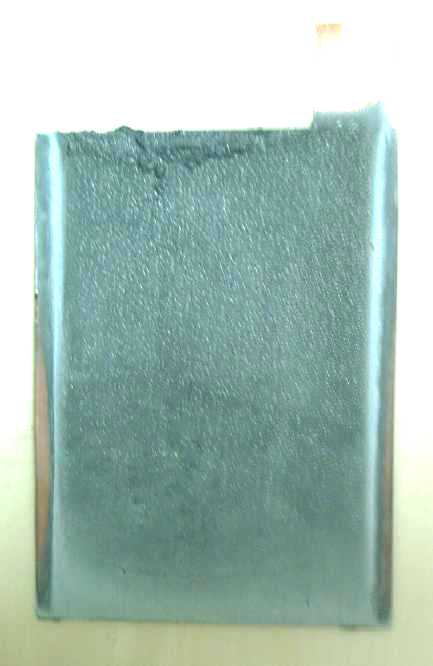 On inspection, the one in the jar had quickly turned
silvery color, then started to get blacker - zinc dendrites? Whatever,
I decided it wasn't good. It brushed off easily with a toothbrush and
made it a more "normal" plated sheet. Feeling with my fingers it had a
more coarse, snadpapery texture near the bottom... So! The notorious
zinc dendrites were forming near the bottom, which was plating more
heavily than the top. That meant that that 'scunge' was probably
actually
inhibiting the plating. I decided to pull it out every few minutes and
brush it off. In about 10 minutes (dried with a paper towel) it weighed
8.1g - so around .8g of zinc (~.65 theoretical amp-hours) plated on.
Another 10 made it 8.8g after brushing off and drying, and 35 made it
9.2.
On inspection, the one in the jar had quickly turned
silvery color, then started to get blacker - zinc dendrites? Whatever,
I decided it wasn't good. It brushed off easily with a toothbrush and
made it a more "normal" plated sheet. Feeling with my fingers it had a
more coarse, snadpapery texture near the bottom... So! The notorious
zinc dendrites were forming near the bottom, which was plating more
heavily than the top. That meant that that 'scunge' was probably
actually
inhibiting the plating. I decided to pull it out every few minutes and
brush it off. In about 10 minutes (dried with a paper towel) it weighed
8.1g - so around .8g of zinc (~.65 theoretical amp-hours) plated on.
Another 10 made it 8.8g after brushing off and drying, and 35 made it
9.2.
But a micrometer showed the plating was nothing like even.
The unplated copper tab was .15mm thick, near the top of the sheet was
.18, the middle was .2 and the bottom was over .7mm. I put it back in
upside down. That left it standing on its tab with ~15mm of the thick
bottom out of the solution.
It occurred to me it might be more uniform if the solution
was stirred, or at least agitated. Also that there were two dead
circulation spaces between the three sheets because of the plastic
sides and bottom. That might contribute to unevenness even if it was
being stirred. Maybe I could rig up a better holder (openings in bottom
& sides), make so it would
stand above the magnetic stirrer?
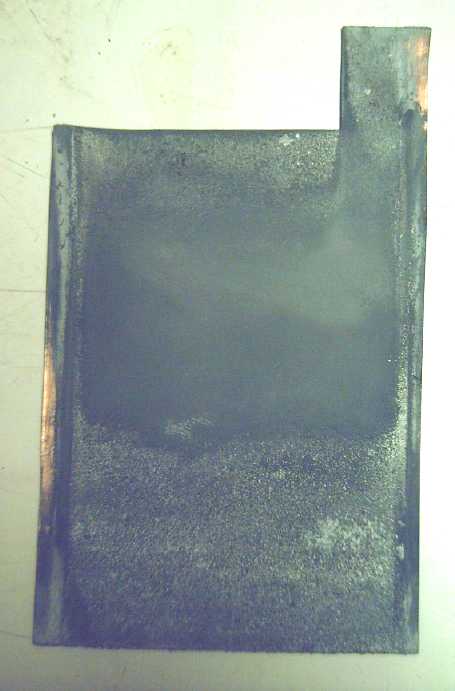 After over 2
hours the piece weighed 12.2g, so
about 4.9g
of zinc had been plated onto the copper. After running it through the
rolling mill a bit (not squashing very hard), the thicker areas had a
mottled, slightly shiny appearance while the thinner (so less if not
un- pressed)
center area was darker. I decided it was good enough.
After over 2
hours the piece weighed 12.2g, so
about 4.9g
of zinc had been plated onto the copper. After running it through the
rolling mill a bit (not squashing very hard), the thicker areas had a
mottled, slightly shiny appearance while the thinner (so less if not
un- pressed)
center area was darker. I decided it was good enough.
4.9g * .82 AH/g = 4.0
amp-hours theoretical.
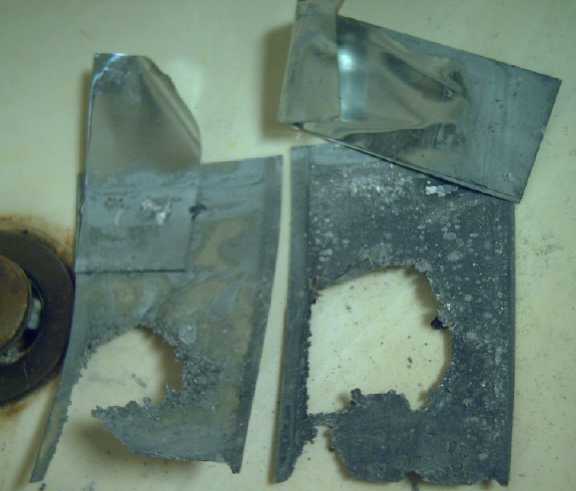 Right: The sacrificed zinc
sheet anodes. Probably couldn't have got much more out of them!
Right: The sacrificed zinc
sheet anodes. Probably couldn't have got much more out of them!
Thinking about what current drive to expect... the "D"
cells might have been 30 amps or so. (Not without considerable voltage
drop!) Their rolled up electrodes were
about 45mm * 460mm. That's about 207 sq.cm. 30A/207=145mA/sq.cm. That's
an awful lot of current per interface area, but zinc should be at least
as
good as metal hydride, and I'm using the same nickel side. That would
make my cell's theoretical capacity about 17 amps. Tall order! But I'd
call 3 amps maintaining decent voltage a
qualified success.
58 sq.cm / 207 sq.cm = .28 of the 10 amp-hour nickel electrode - 2.8
amp-hours. But I'm putting nickel electrode on both sides of the double
sided zinc one - 5.6 amp-hours. That's more than the zinc electrode, so
no point doubling up the nickel pieces. And a single layer should make
for
highest currents.
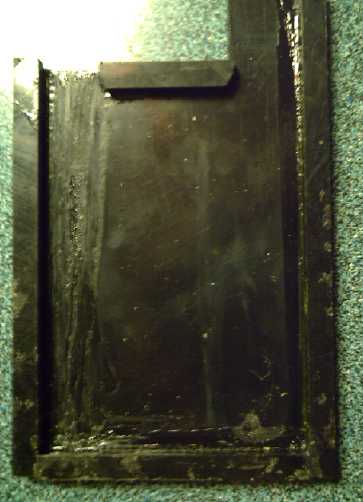 [15th] I decided to avoid
3D printing and cut pieces of the thinnest ABS sheet
(1/16", 1.5mm) for the faces and 1/4" by 1/4" lengths for the edges. I
left a
tab sticking up on one face to protect the soft, easily broken graphite
gasket current
collector sheets.
[15th] I decided to avoid
3D printing and cut pieces of the thinnest ABS sheet
(1/16", 1.5mm) for the faces and 1/4" by 1/4" lengths for the edges. I
left a
tab sticking up on one face to protect the soft, easily broken graphite
gasket current
collector sheets.
I then glued the edges to one face with ABS cement.
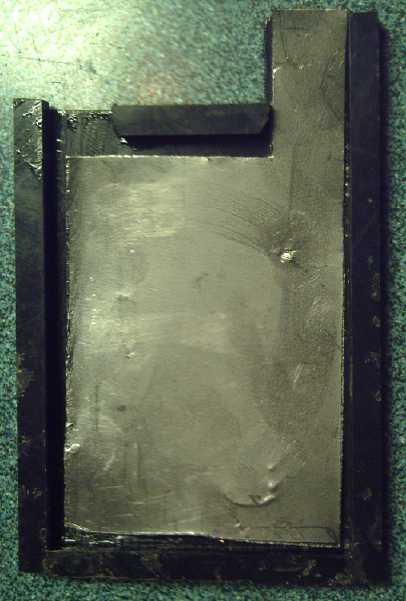 Then I set in one graphite
current collector sheet
Then I set in one graphite
current collector sheet
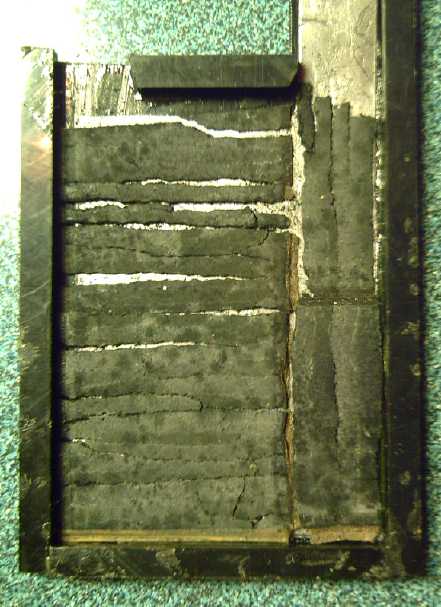 On top of that I placed
some bits of the nickel electrode from the dry
cell.
On top of that I placed
some bits of the nickel electrode from the dry
cell.
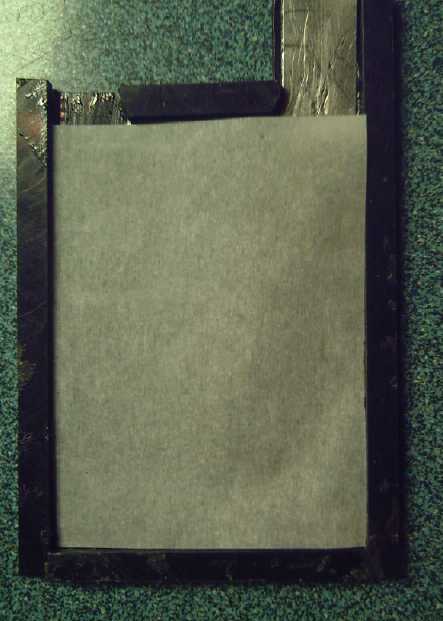 Then a
carefully cut separator sheet of parchment paper. So far so
good...
Then a
carefully cut separator sheet of parchment paper. So far so
good...
Oh wait - A better way to avoid possible gaps in the separator sheet is
to
wrap the center electrode in the parchment paper with an overlap, and
fold over the ends (no potential bare spots or ends to short circuit).
So I removed this paper.
[17th] Okay, the zinc is in metallic
form - charged. So I should put
the cell together charged so it isn't gassing hydrogen in the initial
charging of the nickel. The nickel from the dry cell is probably mostly
discharged to NiOHOH - nickel hydroxide. To discharge, use hydrogen
peroxide. To charge to NiOOH - nickel oxyhydroxide - use bleach
(NaClO). That should leave NaCl salt dissolved, so rinse it in pure
water afterward. Done: 5 minutes+ in bleach both +odes, rinsed.
And I painted the zinc plated copper sheet on both sides
with the osmium doped acetal ester.
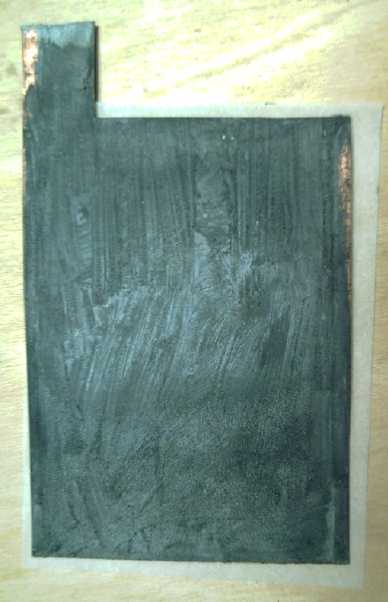
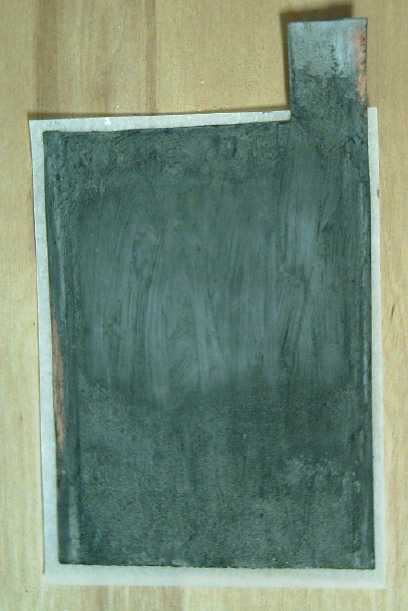 Double sided zinc electrode, zinc plated onto
copper foil and pressed,
Double sided zinc electrode, zinc plated onto
copper foil and pressed,
painted with osmium doping.
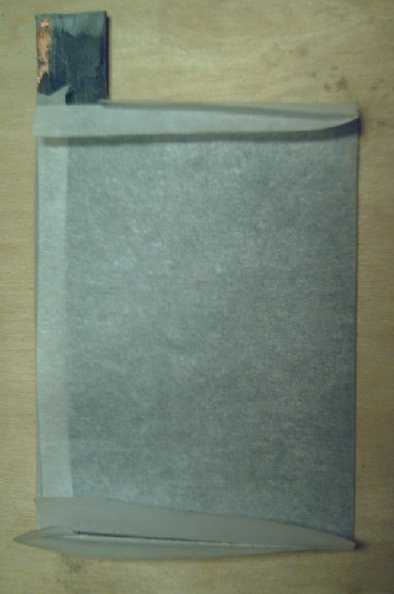 [18th] I
painted both sides of the zinc sheet with a very thin
mixture of agar to stop the zinc ions from migrating, with a bit of
zircon to help raise the hydrogen overvoltage. I hope that's enough
agar. I've made it much thicker before, but I have no particular
thickness to aim at, and the closer together the electrodes are, the
higher the current capacity. (But I think the agar, gelled without salt
in the water, was the main problem with low currents the cell... before
it dried out and got worse.)
[18th] I
painted both sides of the zinc sheet with a very thin
mixture of agar to stop the zinc ions from migrating, with a bit of
zircon to help raise the hydrogen overvoltage. I hope that's enough
agar. I've made it much thicker before, but I have no particular
thickness to aim at, and the closer together the electrodes are, the
higher the current capacity. (But I think the agar, gelled without salt
in the water, was the main problem with low currents the cell... before
it dried out and got worse.)
Then I wrapped it in parchment paper and set it into the
cell.
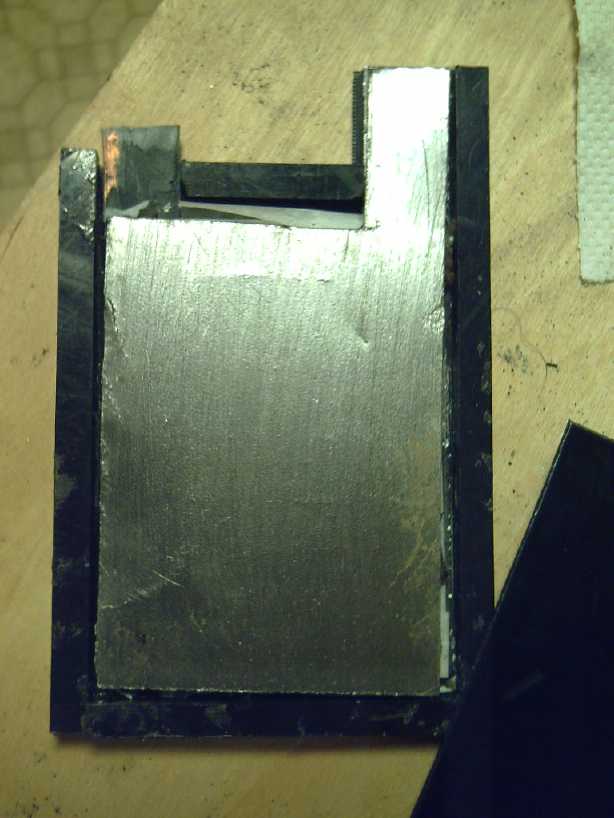 I arranged
bits of the dry cell NiOOH onto the top of the paper in the cell. Then
I set the second current collector on top.
I arranged
bits of the dry cell NiOOH onto the top of the paper in the cell. Then
I set the second current collector on top.
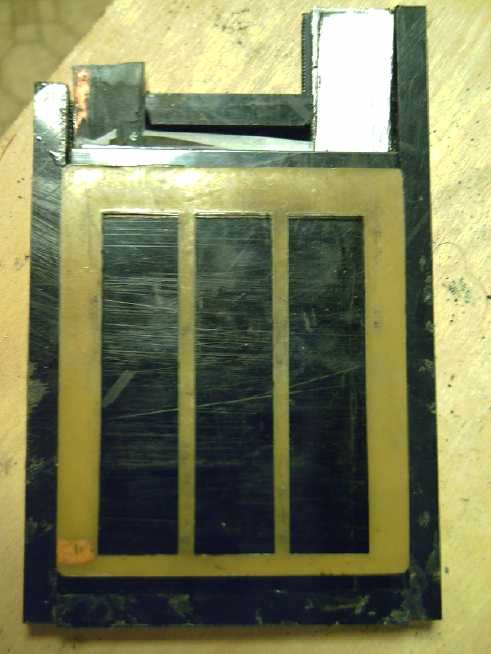 Next: The edge walls
of the case are 6.5mm tall (inside).
How to fill them? The graphite gasket is .5mm and the NiOOH electrode
pieces are 1.0mm. There are two so that's 3mm. The zinc electrode is
about .6mm (even after the coatings). The paper is .1mm. That leaves
about 2.7mm empty space. A piece of plastic for the faces was about
1.5mm and I found a little plastic frame that was 1.0mm and fit just
right. So I put them in and glued the cell together with the ABS
plumbing glue.
Next: The edge walls
of the case are 6.5mm tall (inside).
How to fill them? The graphite gasket is .5mm and the NiOOH electrode
pieces are 1.0mm. There are two so that's 3mm. The zinc electrode is
about .6mm (even after the coatings). The paper is .1mm. That leaves
about 2.7mm empty space. A piece of plastic for the faces was about
1.5mm and I found a little plastic frame that was 1.0mm and fit just
right. So I put them in and glued the cell together with the ABS
plumbing glue.
I noted that it could probably have fit more capacity. Two
double sided zinc electrodes and a double sided nickel electrode would
have added 3.1mm - and another 4 amp-hours to make 8. I probably could
have squeezed that in and still glued it shut. Maybe next time!
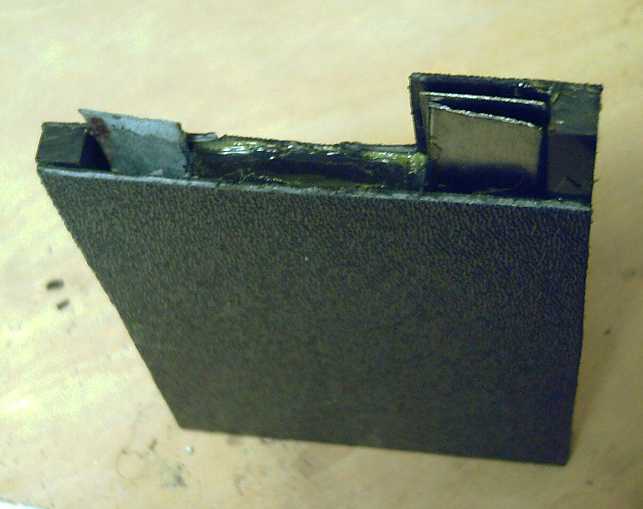 The cell with the top not yet sealed
The cell with the top not yet sealed
Tryout
It was late, but I couldn't resist adding a couple of CCs
of KCl salt electrolyte. It started out at 1.45 volts, but had no
current drive whatsoever and dropped to 1.2V overnight and 1.09V by the
next evening. Do I have it right that in the presence of salt water,
oxygen from the air will oxidize the zinc and discharge the electrode?
I should have waited.
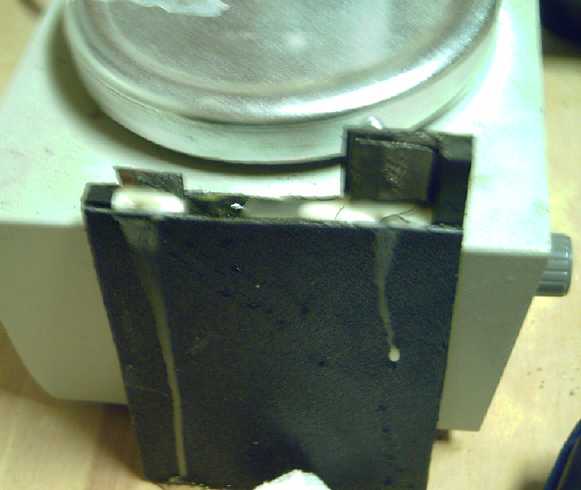 [19th] A
(hopefully) better way to seal the cell:
melt beeswax in a small beaker on the hotplate and pour it into the
holes around the terminals. I melted some beeswax, added 10cc of the
electrolyte to the cell with an eyedropper, and then poured the wax
into the holes. (Oops focus)
[19th] A
(hopefully) better way to seal the cell:
melt beeswax in a small beaker on the hotplate and pour it into the
holes around the terminals. I melted some beeswax, added 10cc of the
electrolyte to the cell with an eyedropper, and then poured the wax
into the holes. (Oops focus)
The bottom left corner was
leaking. I tried melting the bottom corner with the
soldering iron to seal it, but without success. It would seem my
biggest problem with making batteries is leaks in cases.
The voltage was only 1.16, and the current drive was only
.22 amp, which dropped quickly from that figure. It should have been at
least several amps! Maybe I should go back to the mix, half KCl, half
weak KOH. I was getting much higher current drive with that. But I'm
probably missing something since salt should work, as it does in
"standard" dry cells.
Let's see... metallic zinc, bleached NiOOH. Both
electrodes should be charged. I tried charging anyway. It helped a bit.
It
might improve with cycling? But with the leaks it's only going dry out.
I thought the case edges and the glue had seemed solid.
Leaking cells has been a recurring, frustrating problem. Will I have to
give it all up because I can't make cases that don't leak? It seems an
odd thing to keep tripping over in a complex chemistry project!
Well, maybe if I make that external clamp and tighten it
down, at least the bottom will stop leaking?
 [20th] I smeared some ABS
cement glue around the leaking corner. That
seemed to fix it. I drilled a small hole in the top to squirt some
water in through, since it had lost much of it. Then I made the clamp
and clamped it on.
[20th] I smeared some ABS
cement glue around the leaking corner. That
seemed to fix it. I drilled a small hole in the top to squirt some
water in through, since it had lost much of it. Then I made the clamp
and clamped it on.
I couldn't seem to get the water to go in. It very
eventually soaked into the hole, but it took days to refill the cell at
that pace - and I have no idea how saturated it was inside. (Later:
probably none was going in.)
It eventually seemed to work just a little better. I'm
thinking maybe it takes some time for the electrolyte ions to permeate
the agar. Especially with it having leaked out. Maybe I should be
making the agar with salty water? At the moment that would mean making
another cell. I want to get on with the new oven for plastic recycling.
Maybe next month?
[21st] With drops of water [supposedly] going in and some off and on
charging (at a
mere 20-30mA @ 1.9V through 5 ohms), it did seem to be gradually
improving. It had gone from .22 to .45 to .63 amps momentary short
circuit current reading. Ten times as much would of course be more
satisfactory. It drove the "5 ohm" load with over a volt for many
seconds instead of a few. (By the current the "5Ω" was closer to 9Ω --
Much of the extra seemed to be the current sensing resistor in the
meter on "300mA" range, and alligator clips often make crappy
connections!) Open circuit it seemed to hold only around 1.35V for any
length of time.
[22nd] With more low current charging (and maybe with a bit more water)
the performance was starting to creep up. When removed from charge, it
would hold over 1.6 volts for 300 seconds instead of 30. It would run
the 9Ω load at over a volt for 27-40 seconds instead of 15. I saw a
".93" amps momentary short circuit current. I continued adding tiny
drops of water when the previous one had finally soaked in. (At least I
presumed it was soaking in.)
[23rd] Continued very gradual improvement. A difference between this
and most of my previous cells is that electrolyte isn't wicking up the
terminals, corroding the alligator clip leeds and drying out the cell.
In other words, sealing around the terminals with melted beeswax seems
to be working.
[25th] Now it's deteriorating. Maybe for a next test I should try to
find some poly acrylic acid (PAA) like they gelled the zinc with in
that old Sanyo patent? Then if I'm using NiOOH electrodes from a known
to work NiMH cell what, chemicly, would I be doing different from
Sanyo? Their cells worked. ...hmm, except for using salt electrolyte
instead of alkali.
I ordered a package of four Ni-Zn "AA" cells from
AliExpress.com to examine.
I checked at Westlab. They didn't have poly acrylic acid.
Neither did AliExpress. Neither did Amazon. eBay had some "10%
polyacrylic acid solution" for dental work, with no indication of what
the other 90% was. (Probably water, but...)
Oh ya. That's probably what's kept me from trying it out.
Poly Vinyl Alcohol (PVA) Gel?
Then on a whim I looked up PVA, which I had momentarily
confused with PAA. Apparently it too can be turned into a gel -- simply
by
repeated freezing and thawing. Maybe that would work where the agar
seems to severely limit the current unless the electrolyte is quite
alkaline. So: ditch the agar and try PVA? I could take a solution of
water with some, add KCl salt, and add it as the electrolyte. Then
perhaps get a
wholly gelled electrolyte by freezing and thawing it a few times.
So the theory would be that it - along with the osmium
doping - would stop the zincate ions from migrating (and not stop the
salt and hydroxyl ions (K+ & Cl-, OH-)) The salt would already be
all through it from the start. Westlab had PVA and it seems worth a
try, so I ordered some.
Late Note: Cell was better than I thought
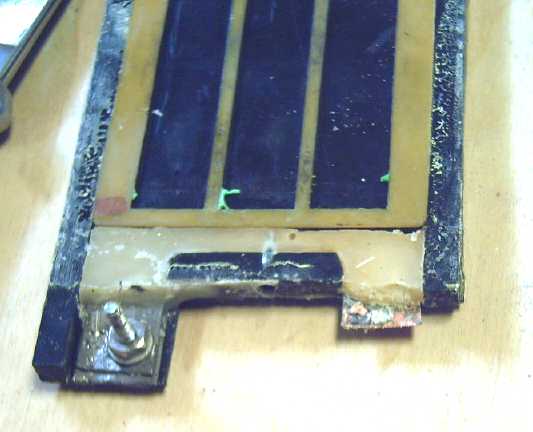 [July 7th] I
pried the top face off the cell by cracking a corner with a sharp knife
and prying with the knife along the crack. To my surprise I did it
without destroying the case. The ABS cement seems to make a weaker bond
than methylene chloride - weaker than the plastic itself. I found the
beeswax had flowed deep into the cell top end and filled in a lot of
the gaps if not all of them. (No wonder it took so much!) The hole I
drilled to refill the leaked electrolyte didn't get through it, which
is why it wouldn't soak in. I removed the spacers and the top current
collector. The NiOOH stuff under it looked very dry. Even with the cell
open I squirted in some KCl electrolyte and put it on charge. Soon it
was performing properly again, with a momentary short circuit current
of over 1.5 amps.
[July 7th] I
pried the top face off the cell by cracking a corner with a sharp knife
and prying with the knife along the crack. To my surprise I did it
without destroying the case. The ABS cement seems to make a weaker bond
than methylene chloride - weaker than the plastic itself. I found the
beeswax had flowed deep into the cell top end and filled in a lot of
the gaps if not all of them. (No wonder it took so much!) The hole I
drilled to refill the leaked electrolyte didn't get through it, which
is why it wouldn't soak in. I removed the spacers and the top current
collector. The NiOOH stuff under it looked very dry. Even with the cell
open I squirted in some KCl electrolyte and put it on charge. Soon it
was performing properly again, with a momentary short circuit current
of over 1.5 amps.
Next I'll heat the zinc 'trode to un-gel the agar, and
paint some on that's gelled with KCl salt in the agar mix (as well as
zircon), then fix up and close the same cell and give it another try.
Electricity
Generation
My Solar Power System
The Usual Daily/Monthly/Yearly Log of Solar
Power Generated [and grid power consumed]
(All times are in PST: clock 48 minutes ahead of local sun time, not
PDT which
is an hour and 48 minutes ahead. (DC) battery system power output
readings are reset to zero
daily (often just for LED lights, occasionally used with other loads:
Chevy Sprint electric car, inverters in power outages or other 36V
loads), while the
grid tied readings are cumulative.)
Daily Figures
Notes: House Main meter (6 digits) accumulates. DC meter is
reset to 0 daily when DC is connected. House East and Cabin meters (4
digits) are reset to 0 when they get near 99.99 (which goes to "100.0")
- owing to loss of second decimal precision.
New Order of Daily Solar Readings (Beginning May 2022):
Date House, House, House, Cabin => Total KWH Solar [Notable
power
Usages; Grid power meter@time] Sky/weather conditions
Main
DC East
(new)
Km = Nissan Leaf electric car drove distance, then car was charged.
May
31st 3177.69, .08, 57.09, 34.36 => 12.04 [96675@20:30] Another dull
day.
June (I am no longer going to reset the DC charging reading
daily. It will be cumulative.)
01st 3186.97, .04, 63.23, 39.63 => 20.73 [96715@20:30] hazy
sun/light
clouds
02d 3193.79, .12, 67.65, 43.40 => 14.03 [55Km; 96751@20:30]
Dull. Sprinkles.
03rd 3197.17, .18, 69.72, 45.14 => 7.25 [90Km;
96798@20:00] Fog, overcast, rain.
04th 3206.09, .25, 76.90, 50.98 => 22.19 [60Km; 96826@21:00] A fair
bit of sun.
05th 3210.61, .31, 79.44, 53.14 => 9.28 [96855@20:30]
Overcast. Rain PM.
06th 3219.79, .38, 86.31, 58.48 => 21.46 [96884@21:00] Some good sun
in PM.
07th 3224.48, .46, 89.33, 61.04 => 10.35 [55Km; 96913@21:00]
Overcast. Rain later PM.
08th 3231.74, .55, 94.31, 65.38 => 16.67 [55Km; 96952@20:30] Mostly
overcast, windy.
09th 3233.90, .63, 01.13, 66.38 => 4.37 [96989@20:00] Storm:
wind, rain, cold. 11° at 10 AM solar time. Not a very nice Juneuary
so far.
10th 3241.27, .72, 05.96, 70.53 => 16.44 [85Km; 97033@20:30] It
seemed like such a nice day as it started, by evening it was just wind
and rain again. Earlier it was 12-13° and so the car used less KWH
than usual - 27% battery left instead of 20% to Port C. & back -
and drove at higher speeds.
11th 3248.05, .80, 10.42, 74.54 => 15.33 [55Km; 97066@21:30]
12th 3252.85, .86, 14.33, 77.54 => 12.31 [97090@22:30]
13th 3261.91, .92, 19.71, 82.49 => 19.42 [65Km; 97119@21:30] A day
with some nice parts!
14th 3274.08, .98, 28.74, 90.07 => 29.37 [55Km; 97144@20:30]
Sunny! Yay! (New record for a day)
15th 3285.22, 1.11, 36.58, 96.69 => 25.73 [97163@21:00] Sunny most
of
the day - again!
16th 3296.01, 1.25, 43.70, 06.37 => 24.42 [60Km; 97191@21:30] Mor
sun!
Wow!
17th 3305.06, 1.32, 50.45, 11.88 => 21.58 [90Km; 97207@21:30] Cloudy
AM, soon cleared up - Again!
18th 3318.35, 1.36, 59.71, 20.29 => 31.00 [55Km;
97232@22:00] Beautiful
clear day! (& another new record!)
19th 3322.51, 1.47, 62.35, 22.68 => 9.30 [97245@21:30]
Overcast. Later PM, rain.
20th 3327.70, 1.55, 65.61, 25.74 => 11.59 [97263@21:30] Mor overcast.
21st 3333.64, 1.63, 69.91, 29.23 => 13.79 [60Km; 97300@22:00]
"Summer" solstice. Cloudy again.
22d 3340.04, 1.66, 74.25, 32.88 => 14.54 [60Km; 97332@21:30]
Mainly clouds, with sunny breaks & rainy breaks.
23rd 3346.06, 1.68, 78.27, 36.26 => 13.44 [97360@22:30] Yet
mor overcast.
24th 3358.44, 1.71, 86.82, 43.98 => 28.58 [105Km; 97395@21:00]
Cloudy for a bit in AM then SUNNY!
25th 3369.00, 1.73, 94.26, 50.40 => 24.44 [95Km(not charged until
Monday - oops); 97424@21:30] Some sun, a few thin clouds - mostly jet
trails
26th 3381.77, 1.81, 08.71, 58.51 => 28.67 [97444@21:30] Lots of sun,
WARM!
27th 3394.58, 1.90, 17.43, 66.55 => 29.66 [55Km+25th; 97484@21:00]
Beautiful sunny day! AM jet trails didn't "stick" long. Turned off
bitcoin miner early evening - not mining much, certainly don't need any
heat!
28th 3401.47, 1.95, 22.10, 70.51 => 15.57 [97499@21:00] Overcast.
29th 3405.28, 2.02, 24.52, 72.48 => 8.27 [55Km; 97520@19:30]
Really overcast.
30th 3412.23, 2.10, 29.22, 76.85 => 16.10 [97539@21:00]
July
1st 3420.60, 2.16, 30.10, 81.59 => 16.10 [97562@21:30; 90Km]
2d 3431.92, 2.22, 37.50*,88.59=> 25.78 [55Km; 97585@20:30]
*Estimate owing to shuffling power meters around. One of them (not the
one in use until now) turns out to read 30% lower than the others!
3rd 3444.11, 2.57, 08.83, 96.58 => 29.36 [97602@21:00] BEAUTIFUL
sunny day! (They do happen!) Hey! one of the meters reads lower than
the others!
4th 3450.02, 2.67, 12.81, 03.58 => 13.57 [97614@21:30] Overcast.
5th 3454.67, 2.72, Oops*,06.16 => 7.28 [95Km;
97645@21:30] *Switched power bar off previous eve. Zero KWH.
Chart of daily KWH from solar panels.
(Compare JUNE 2022
(middle) with May 2022 & with June 2021 but note number of solar
panels
differs.)
Days of
__ KWH
|
MAY 2022
(18 solar panels)
|
June 2022
(18 sol. panels)
|
June 2021
(12 solar panels)
|
0.xx
|
|
|
|
1.xx
|
|
|
|
2.xx
|
|
|
|
3.xx
|
|
|
1
|
4.xx
|
|
1
|
1
|
5.xx
|
|
|
2
|
6.xx
|
|
|
2
|
7.xx
|
1
|
1
|
2
|
8.xx
|
2
|
1
|
5
|
9.xx
|
|
2
|
3
|
10.xx
|
1
|
1
|
1
|
11.xx
|
|
1
|
3
|
12.xx
|
2
|
1
|
1
|
13.xx
|
3
|
2
|
1
|
14.xx
|
1
|
2
|
2
|
15.xx
|
2
|
2
|
3
|
16.xx
|
2
|
3
|
2
|
17.xx
|
3
|
|
1
|
18.xx
|
3
|
|
<= chart ended here until April 2022!
|
19.xx
|
4
|
1
|
<= In April the solar 2 panels mounted
on the pole last fall & improved... |
20.xx
|
|
1
|
<= connections & more grid tie
microinverters started to pay off.
(not to mention a big spruce cut down!)
|
21.xx
|
|
2
|
|
22.xx
|
|
1
|
|
23.xx
|
1
|
|
|
24.xx
|
2
|
2
|
|
25.xx
|
1
|
1
|
|
26.xx
|
|
|
|
27.xx
|
1
|
|
<= In May 2022 the 3 new panels...
|
28.xx
|
1
|
2
|
<= on the carport roof brought solar...
|
29.xx
|
1
|
2
|
<= collection to whole new levels.
|
30.xx
|
|
|
|
31.xx
|
|
1
|
egads! new record appoaching solstice!
|
Total KWH
for month
|
547.74 (18 panels)
all-time record!
|
536.52
|
254.76
|
Km Driven
on Electricity
|
934.1 Km
(~140 KWH?)
|
1100? Km
(~160? KWH?)
|
-
|
Things Noted - June 2022
* On July 1st I wrote down my Leaf EV mileage for June from the trip
meter and
reset it for July. Where I put the number I have no idea.
* By and large the weather in the first half of June wasn't as sunny as
in May, leading to a lower overall monthly solar collection.
* In later June, when there is maximum annual sunshine (if it's not
cloudy), power seemed to drop a bit from "expected" maximums that
occurred in May and earlier in June. For instance the meter showed over
1000 watts from the carport(3)+pole(2) solar panels not long after all
was connected. In late June I didn't see even 850W. I attribute this
mostly to the fact that solar collectors work better if they're cold,
and the weather from June 18th was much warmer on sunny days. (And
cloudy days were much warmer than cloudy days in May.)
Monthly Summaries: Solar Generated KWH [& Power used from
grid KWH]
Month: House system (+ DC system at house) + Cabin system = KWH made
[used from grid]
2019
March 1-31: 116.19 + ------ + 105.93 = 222.12 KWH - solar [786 KWH
used from
grid] (10 solar panels
total)
April - 1-30: 136.87 + ------ + 121.97 = 258.84 KWH [608 KWH]
May - 1-31: 156.23 + ------ + 147.47 = 303.70 KWH [543 KWH] (11th
solar panel connected on lawn on 26th)
June - 1-30: 146.63 + 15.65 + 115.26 = 277.54 KWH [374 KWH] (36V, 250W
Hot Water Heater installed on 7th)
July - 1-31: 134.06 + 19.06 + 120.86 = 273.98 KWH [342 KWH]
August 1-31:127.47 + 11.44+91.82+(8/10)*96.29 = 307.76 KWH [334 KWH]
(12th solar panel connected
on lawn Aug.
1)
Sept.- 1-30: 110.72 + 15.30 + 84.91 = 210.93 KWH [408 KWH]
(solar includes 2/10 of 96.29)
Oct. - 1-31: 55.67 + 13.03 + 51.82 = 120.52 KWH, solar
[635 KWH used from grid]
Nov. - 1-30: 36.51 + 6.31 + 26.29 = 69.11
KWH, solar [653 KWH used from grid]
Dec. - 1-23: 18.98 + .84* + 11.70 =
31.52
KWH, solar + wind [711 KWH + 414 (while away) = 1125 from grid]
2020
Jan. - 6-31: 17.52 + ------* + 10.61 = 28.13 KWH,
solar+
wind [1111 KWH from grid]
Feb. - 1-29: 56.83 + ------* + 35.17 = 92.00 KWH,
solar + wind [963 KWH from grid]
* The solar DC system was running the kitchen hot water
tank. Now it's only running a couple of
lights - not (usually) worth reporting. So there's just the 2 grid tie
systems:
house and "roof over travel trailer" (AKA "Cabin").
One year of solar!
March - 1-31: 111.31 + 87.05 = 198.37 KWH solar total
[934 KWH from grid]
April - 1-30: 156.09 + 115.12 = 271.21 [784 KWH
from grid]
May - 1-31: 181.97 + 131.21 = 313.18 KWH
Solar [723 KWH from grid]
June - 1-30: 164.04 + 119.81 = 283.82 KWH Solar [455 KWH
from grid]
July - 1-31: 190.13 + 110.05 = 300.18 KWH Solar [340
KWH from grid]
August- 1-31: 121.81 + 83.62 = 205.43 KWH Solar [385KWH
from Grid]
Sept. - 1-30: 110.68 + 65.09 = 175.77 KWH Solar [564
KWH used from grid]
Oct. - 1-31: 67.28 + 42.55 = 109.83
KWH Solar [1360 KWH from grid -- Renters!]
Nov. - 1-30: 35.70 + 20.79 = 56.49
KWH of Solar [1301 KWH from grid]
Dec. - 1-31: 19.78 + 11.31 = 31.09
KWH Solar [1078 KWH used from grid]
2021
Jan. - 1-31: 25.47 + 18.58 = 44.05
KWH Solar [1185 KWH used from grid] (1
solar panel moved to DC system only -- 11 panels)
Feb. - 1-28: 47.18 + 33.22 = 80.40
KWH Solar [1121 KWH used from grid]
Two years of solar!
March - 1-31: 81.73 + 55.22 + 2.2 (DC) = 139.15 KWH
Solar
[1039 KWH grid]
April - 1-30: 161.83 + 112.35 + .44(DC) = 274.62 KWH
Solar
[680 KWH from grid]
May - 1-31: 156.25 + 97.22 + 1.29(DC) = 254.76
KWH
Solar [678 KWH from grid]
June - 1-30: 197.84 + 112.07 + 2.21(DC) = 312.12 KWH Solar
[& 448 KWH from grid] (Connected
12th
solar
panel
--
13
panels
total
but
one
goes
to DC system only.)
July - 1-31: 204.35 + 121.21 + 4.06(DC) = 329.62 KWH
Solar [426 KWH from grid; 150(?) KWH used by Nissan Leaf]
August- 1-31: 176.19 + 102.91 + 5.37(DC) = 284.47 KWH Solar [477 KWH
from grid; 165 KWH (est) used by car]
Sept. - 1-30: 94.35 + 51.34 + 3.30(DC) =
152.29 KWH Solar [590 KWH from grid; 155 KWH (est) used by car]
Oct. - 1-31: 77.52 + 41.85 +
4.10(DC) = 123.47 KWH Solar [1066 KWH from grid; 150 KWH (est) used by
car] (2 new panels on pole
making 14 --
but they are mostly in shadows all winter.)
Nov. - 1-31: 34.69 + 18.92 + 3.82 = 57.43
KWH Solar [1474 KWH from grid (ouch!); 140 (est) used by car]
Dec. - 1-31: 24.00 + 5.22 + 3.76 = 32.98 [1589 KWH from grid (ouch
again! Must be the -10°'s); 120 KWH used by car] (New switches allow switching
some panels
between AC and DC as needed, so all 15 are productively employed.)
2022
Jan. - 1-31: 32.83 + 20.54 + 4.57 = 57.94 KWH Solar [2556 from
grid] Double ouch! Trailer 400W heater, Perry's RV 500W heater, bedroom
heat, car using extra power (100 KWH with less driving)... and so
little
sun!
Feb. - 1-28: 66.63 + 32.09 + 3.42(DC) = 102.14 KWH Solar [1118
KWH from grid; 130 (est) used by car]
Three years of solar!
March - 1-31: 128.53 + 82.29 + 3.66(DC) = 214.48 [1124 KWH from grid;
160 KWH (est) used by car]
April - 1-30: 251.29 + 149.87 + 3.01(DC) = 404.17 KWH [911
KWH; est. 170 KWH used by car]
May - 1-31: 255.01(house) + 6.46(DC) +
140.46(carport) + 145.91(cabin) = 547.74 KWH Solar [933 KWH from grid;
140 KWH (est) used by car; Bitcoin miner using extra power from 22nd
on.] (3 new solar panels
on carport roof
-- sunniest location around -- total 18)
June - 1-30: 234.54 + 2.10 + 160.70 + 139.18 = 536.52 KWH
[from grid: 864 KWH - dang bitcoin miner!]
Annual Totals
1. March 2019-Feb. 2020: 2196.15 KWH Solar [used 7927 KWH
from
grid]
2. March 2020-Feb. 2021: 2069.82 KWH Solar [used 11294 KWH from grid]
(More electric heat - BR, Trailer & Perry's RV)
3. March 2021-Feb. 2022: 2063.05 KWH Solar [used 10977 KWH from grid]
Money Saved or Earned - @ 12¢ [All BC residential elec. rate] ; @
50¢ [2018 cost of diesel fuel to BC Hydro] ; @ 1$ per KWH [total
cost to BC Hydro
in 2022 according to an employee]:
1. 263.42$ ; 1097.58$ ; 2196.15$
2. 248.38$ ; 1034.91$ ; 2069.82$
3. 247.57$ ; 1031.53$ ; 2063.05$
It can be seen that the benefit to the society as a whole
on Haida Gwaii from solar power installations is much greater than the
cost savings to the individual user of electricity, thanks to the heavy
subsidization of our power
owing to the BC government policy of having the same power rate across
the entire province regardless of the cost of production. And it can be
insurance: With a little
extra equipment and a battery, solar can deliver essential power in
electrical outages however long.
https://www.TurquoiseEnergy.com
Haida Gwaii, BC Canada

 I spent a lot
of time on gardening again. Nevertheless the
weeds grow fast and a lot of it looks more like weed patch than garden.
But along with all I'm going to have a lot of potatoes for
calories if the food shortage does go global this coming winter - or
for a few years afterward, since they reseed themselves even if you
think you harvested them all. They've become weeds almost throughout
the garden.
I spent a lot
of time on gardening again. Nevertheless the
weeds grow fast and a lot of it looks more like weed patch than garden.
But along with all I'm going to have a lot of potatoes for
calories if the food shortage does go global this coming winter - or
for a few years afterward, since they reseed themselves even if you
think you harvested them all. They've become weeds almost throughout
the garden. The solar panels again did much better with the
two panels on the pole and more especially with the three new
panels on the carport roof (sunniest place), yielding 536 KWH for the
month from the 18
panels. Until this year, 330 KWH was about the summer maximum
production from 12 or 13 panels. When I can find the time, I'll move
the three panels on the lawn also
onto the carport roof beside the first three.
The solar panels again did much better with the
two panels on the pole and more especially with the three new
panels on the carport roof (sunniest place), yielding 536 KWH for the
month from the 18
panels. Until this year, 330 KWH was about the summer maximum
production from 12 or 13 panels. When I can find the time, I'll move
the three panels on the lawn also
onto the carport roof beside the first three. I did
patheticly little work on the
"freezer-as-plastic-melting-oven", making the two-piece lid from two
freezer lids, with fiberglass insulation lower and sprayed foam molded
on the upper. In doing this I had to put the smaller one on top, so if
I leave it in the rain it will run inside the lid around the edges. I
suppose I should put rock wool or something around the rim since it's
no seal.
I did
patheticly little work on the
"freezer-as-plastic-melting-oven", making the two-piece lid from two
freezer lids, with fiberglass insulation lower and sprayed foam molded
on the upper. In doing this I had to put the smaller one on top, so if
I leave it in the rain it will run inside the lid around the edges. I
suppose I should put rock wool or something around the rim since it's
no seal. I tried making
a new Ni-Zn gelled battery cell. It didn't work well but I made a
little progress in improving the construction and I have a couple of
ideas to fix problems for next try(s). The agar gel seems again to
block current flow. (I thought I had it working well about 3 years ago!)
I tried making
a new Ni-Zn gelled battery cell. It didn't work well but I made a
little progress in improving the construction and I have a couple of
ideas to fix problems for next try(s). The agar gel seems again to
block current flow. (I thought I had it working well about 3 years ago!)


 I
ordered a 24 volt DC well pump (somewhere on AliExpress.com). It
arrived on the 22nd. It was beautifully packed in plywood box with 12
metal clamps bent over to hold it shut and the whole covered in yellow
tape. It was also a great looking product, with a separate BLDC motor
motor controller that looks waterproof and a 16 page instruction book.
The book says one can power it with batteries or directly from solar
panels.
I
ordered a 24 volt DC well pump (somewhere on AliExpress.com). It
arrived on the 22nd. It was beautifully packed in plywood box with 12
metal clamps bent over to hold it shut and the whole covered in yellow
tape. It was also a great looking product, with a separate BLDC motor
motor controller that looks waterproof and a 16 page instruction book.
The book says one can power it with batteries or directly from solar
panels. My friend Jim
at AGO Environmental Electronics in Victoria (BC) found a place in
China to import 302 amp-hour cells from, and he bought a considerable
batch of them. I bought four from him, which I can use either in
parallel for an extremely high amperage HHO torch system power supply
(3.6V), or in series as a 12 volt battery.
My friend Jim
at AGO Environmental Electronics in Victoria (BC) found a place in
China to import 302 amp-hour cells from, and he bought a considerable
batch of them. I bought four from him, which I can use either in
parallel for an extremely high amperage HHO torch system power supply
(3.6V), or in series as a 12 volt battery. When I go for
a walk on the beach when the tides run higher (new moon, full moon),
and if I chance to venture up near the high tide mark, I usually find a
bottle or two... and some disintegrating polystyrene foam... and more,
and more, and I sometimes come home with an armload - all I can carry
without having brought a bag, even for a few days in a row.
When I go for
a walk on the beach when the tides run higher (new moon, full moon),
and if I chance to venture up near the high tide mark, I usually find a
bottle or two... and some disintegrating polystyrene foam... and more,
and more, and I sometimes come home with an armload - all I can carry
without having brought a bag, even for a few days in a row.









 [19th] My bee palace is
still sitting out there empty. But as I
approached a scotch broom bush, it was buzzing. The buzzing subsided.
It seemed my approach had spooked the bees and they had left. I only
got a glimpse of part of one in a flower on the far side before it too
departed. They were either quite small bumblebees or honeybees.
[19th] My bee palace is
still sitting out there empty. But as I
approached a scotch broom bush, it was buzzing. The buzzing subsided.
It seemed my approach had spooked the bees and they had left. I only
got a glimpse of part of one in a flower on the far side before it too
departed. They were either quite small bumblebees or honeybees.

 Then I decided
to use them the other way around: the
original lid facing down into the oven with its vertical edges all
around facing up and with its original fiberglass insulation inside.
Then the foam insulated lid would go metal side up on top of that. So
it would still have metal inside and outside. I figure the fiberglass
is the best insulation for the inside. The one drawback is that instead
of rain running off, it would want to fill the inside of the lid. I'll
have to keep it dry. I probably would have to/want to anyway. I screwed
the two together with "self drilling" sheet metal screws.
Then I decided
to use them the other way around: the
original lid facing down into the oven with its vertical edges all
around facing up and with its original fiberglass insulation inside.
Then the foam insulated lid would go metal side up on top of that. So
it would still have metal inside and outside. I figure the fiberglass
is the best insulation for the inside. The one drawback is that instead
of rain running off, it would want to fill the inside of the lid. I'll
have to keep it dry. I probably would have to/want to anyway. I screwed
the two together with "self drilling" sheet metal screws.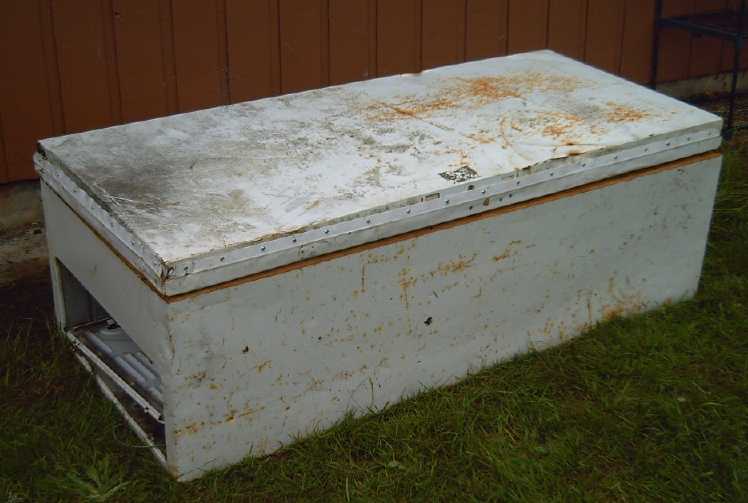
 [21st] It still needed a
test, and I needed to estimate how many bags I
would need. I stapled some plastic up to about 5 feet from the base of
the wall studs in the cabin. I took a bag of the dried grass and
"fluffed" it as I poured it loosely into the 16 inch centers wall
space. It filled nicely. It took about 3/5 or 2/3 of a bag to fill that
space.
[21st] It still needed a
test, and I needed to estimate how many bags I
would need. I stapled some plastic up to about 5 feet from the base of
the wall studs in the cabin. I took a bag of the dried grass and
"fluffed" it as I poured it loosely into the 16 inch centers wall
space. It filled nicely. It took about 3/5 or 2/3 of a bag to fill that
space. But the
plastic bulged out considerably. I screwed a piece
of plywood over the next stud and filled it up to over 4 feet high. It
took less than the remaining grass in the bag. So it might be one bag
per 12 foot tall wall stud, which suggests I'll need around 100 bags of
grass. At the rate I've been working on the cabin, I have at least 2
summers to collect all that grass!
But the
plastic bulged out considerably. I screwed a piece
of plywood over the next stud and filled it up to over 4 feet high. It
took less than the remaining grass in the bag. So it might be one bag
per 12 foot tall wall stud, which suggests I'll need around 100 bags of
grass. At the rate I've been working on the cabin, I have at least 2
summers to collect all that grass! When I
unscrewed the plywood the plastic bulged out and
the loose grass settled into about 3/4 of the height. I have the
impression that if it's just slightly patted in at the top, it all goes
down a bit. I think it won't settle further and leave an uninsulated
gap at the top.
When I
unscrewed the plywood the plastic bulged out and
the loose grass settled into about 3/4 of the height. I have the
impression that if it's just slightly patted in at the top, it all goes
down a bit. I think it won't settle further and leave an uninsulated
gap at the top. [29th] I chanced again to
talk to my neighbor. He mentioned
that if I
wanted more he had dumped it in the bushes in a certain place and that
I should take my lawn tractor over there with the trailer. I had doubts
about collecting anything but the latest mowing, but he had spread it
out, dumping in an area rather than one tall pile, and I got a trailer
full.
I again took it and shook it out over a wide area of my lawn to dry.
(Now if only the sun would come out!)
[29th] I chanced again to
talk to my neighbor. He mentioned
that if I
wanted more he had dumped it in the bushes in a certain place and that
I should take my lawn tractor over there with the trailer. I had doubts
about collecting anything but the latest mowing, but he had spread it
out, dumping in an area rather than one tall pile, and I got a trailer
full.
I again took it and shook it out over a wide area of my lawn to dry.
(Now if only the sun would come out!) On inspection, the one in the jar had quickly turned
silvery color, then started to get blacker - zinc dendrites? Whatever,
I decided it wasn't good. It brushed off easily with a toothbrush and
made it a more "normal" plated sheet. Feeling with my fingers it had a
more coarse, snadpapery texture near the bottom... So! The notorious
zinc dendrites were forming near the bottom, which was plating more
heavily than the top. That meant that that 'scunge' was probably
actually
inhibiting the plating. I decided to pull it out every few minutes and
brush it off. In about 10 minutes (dried with a paper towel) it weighed
8.1g - so around .8g of zinc (~.65 theoretical amp-hours) plated on.
Another 10 made it 8.8g after brushing off and drying, and 35 made it
9.2.
On inspection, the one in the jar had quickly turned
silvery color, then started to get blacker - zinc dendrites? Whatever,
I decided it wasn't good. It brushed off easily with a toothbrush and
made it a more "normal" plated sheet. Feeling with my fingers it had a
more coarse, snadpapery texture near the bottom... So! The notorious
zinc dendrites were forming near the bottom, which was plating more
heavily than the top. That meant that that 'scunge' was probably
actually
inhibiting the plating. I decided to pull it out every few minutes and
brush it off. In about 10 minutes (dried with a paper towel) it weighed
8.1g - so around .8g of zinc (~.65 theoretical amp-hours) plated on.
Another 10 made it 8.8g after brushing off and drying, and 35 made it
9.2. After over 2
hours the piece weighed 12.2g, so
about 4.9g
of zinc had been plated onto the copper. After running it through the
rolling mill a bit (not squashing very hard), the thicker areas had a
mottled, slightly shiny appearance while the thinner (so less if not
un- pressed)
center area was darker. I decided it was good enough.
After over 2
hours the piece weighed 12.2g, so
about 4.9g
of zinc had been plated onto the copper. After running it through the
rolling mill a bit (not squashing very hard), the thicker areas had a
mottled, slightly shiny appearance while the thinner (so less if not
un- pressed)
center area was darker. I decided it was good enough. Right: The sacrificed zinc
sheet anodes. Probably couldn't have got much more out of them!
Right: The sacrificed zinc
sheet anodes. Probably couldn't have got much more out of them! [15th] I decided to avoid
3D printing and cut pieces of the thinnest ABS sheet
(1/16", 1.5mm) for the faces and 1/4" by 1/4" lengths for the edges. I
left a
tab sticking up on one face to protect the soft, easily broken graphite
gasket current
collector sheets.
[15th] I decided to avoid
3D printing and cut pieces of the thinnest ABS sheet
(1/16", 1.5mm) for the faces and 1/4" by 1/4" lengths for the edges. I
left a
tab sticking up on one face to protect the soft, easily broken graphite
gasket current
collector sheets. Then I set in one graphite
current collector sheet
Then I set in one graphite
current collector sheet On top of that I placed
some bits of the nickel electrode from the dry
cell.
On top of that I placed
some bits of the nickel electrode from the dry
cell. Then a
carefully cut separator sheet of parchment paper. So far so
good...
Then a
carefully cut separator sheet of parchment paper. So far so
good...

 [18th] I
painted both sides of the zinc sheet with a very thin
mixture of agar to stop the zinc ions from migrating, with a bit of
zircon to help raise the hydrogen overvoltage. I hope that's enough
agar. I've made it much thicker before, but I have no particular
thickness to aim at, and the closer together the electrodes are, the
higher the current capacity. (But I think the agar, gelled without salt
in the water, was the main problem with low currents the cell... before
it dried out and got worse.)
[18th] I
painted both sides of the zinc sheet with a very thin
mixture of agar to stop the zinc ions from migrating, with a bit of
zircon to help raise the hydrogen overvoltage. I hope that's enough
agar. I've made it much thicker before, but I have no particular
thickness to aim at, and the closer together the electrodes are, the
higher the current capacity. (But I think the agar, gelled without salt
in the water, was the main problem with low currents the cell... before
it dried out and got worse.) I arranged
bits of the dry cell NiOOH onto the top of the paper in the cell. Then
I set the second current collector on top.
I arranged
bits of the dry cell NiOOH onto the top of the paper in the cell. Then
I set the second current collector on top.  Next: The edge walls
of the case are 6.5mm tall (inside).
How to fill them? The graphite gasket is .5mm and the NiOOH electrode
pieces are 1.0mm. There are two so that's 3mm. The zinc electrode is
about .6mm (even after the coatings). The paper is .1mm. That leaves
about 2.7mm empty space. A piece of plastic for the faces was about
1.5mm and I found a little plastic frame that was 1.0mm and fit just
right. So I put them in and glued the cell together with the ABS
plumbing glue.
Next: The edge walls
of the case are 6.5mm tall (inside).
How to fill them? The graphite gasket is .5mm and the NiOOH electrode
pieces are 1.0mm. There are two so that's 3mm. The zinc electrode is
about .6mm (even after the coatings). The paper is .1mm. That leaves
about 2.7mm empty space. A piece of plastic for the faces was about
1.5mm and I found a little plastic frame that was 1.0mm and fit just
right. So I put them in and glued the cell together with the ABS
plumbing glue.
 [19th] A
(hopefully) better way to seal the cell:
melt beeswax in a small beaker on the hotplate and pour it into the
holes around the terminals. I melted some beeswax, added 10cc of the
electrolyte to the cell with an eyedropper, and then poured the wax
into the holes. (Oops focus)
[19th] A
(hopefully) better way to seal the cell:
melt beeswax in a small beaker on the hotplate and pour it into the
holes around the terminals. I melted some beeswax, added 10cc of the
electrolyte to the cell with an eyedropper, and then poured the wax
into the holes. (Oops focus) [20th] I smeared some ABS
cement glue around the leaking corner. That
seemed to fix it. I drilled a small hole in the top to squirt some
water in through, since it had lost much of it. Then I made the clamp
and clamped it on.
[20th] I smeared some ABS
cement glue around the leaking corner. That
seemed to fix it. I drilled a small hole in the top to squirt some
water in through, since it had lost much of it. Then I made the clamp
and clamped it on. [July 7th] I
pried the top face off the cell by cracking a corner with a sharp knife
and prying with the knife along the crack. To my surprise I did it
without destroying the case. The ABS cement seems to make a weaker bond
than methylene chloride - weaker than the plastic itself. I found the
beeswax had flowed deep into the cell top end and filled in a lot of
the gaps if not all of them. (No wonder it took so much!) The hole I
drilled to refill the leaked electrolyte didn't get through it, which
is why it wouldn't soak in. I removed the spacers and the top current
collector. The NiOOH stuff under it looked very dry. Even with the cell
open I squirted in some KCl electrolyte and put it on charge. Soon it
was performing properly again, with a momentary short circuit current
of over 1.5 amps.
[July 7th] I
pried the top face off the cell by cracking a corner with a sharp knife
and prying with the knife along the crack. To my surprise I did it
without destroying the case. The ABS cement seems to make a weaker bond
than methylene chloride - weaker than the plastic itself. I found the
beeswax had flowed deep into the cell top end and filled in a lot of
the gaps if not all of them. (No wonder it took so much!) The hole I
drilled to refill the leaked electrolyte didn't get through it, which
is why it wouldn't soak in. I removed the spacers and the top current
collector. The NiOOH stuff under it looked very dry. Even with the cell
open I squirted in some KCl electrolyte and put it on charge. Soon it
was performing properly again, with a momentary short circuit current
of over 1.5 amps.